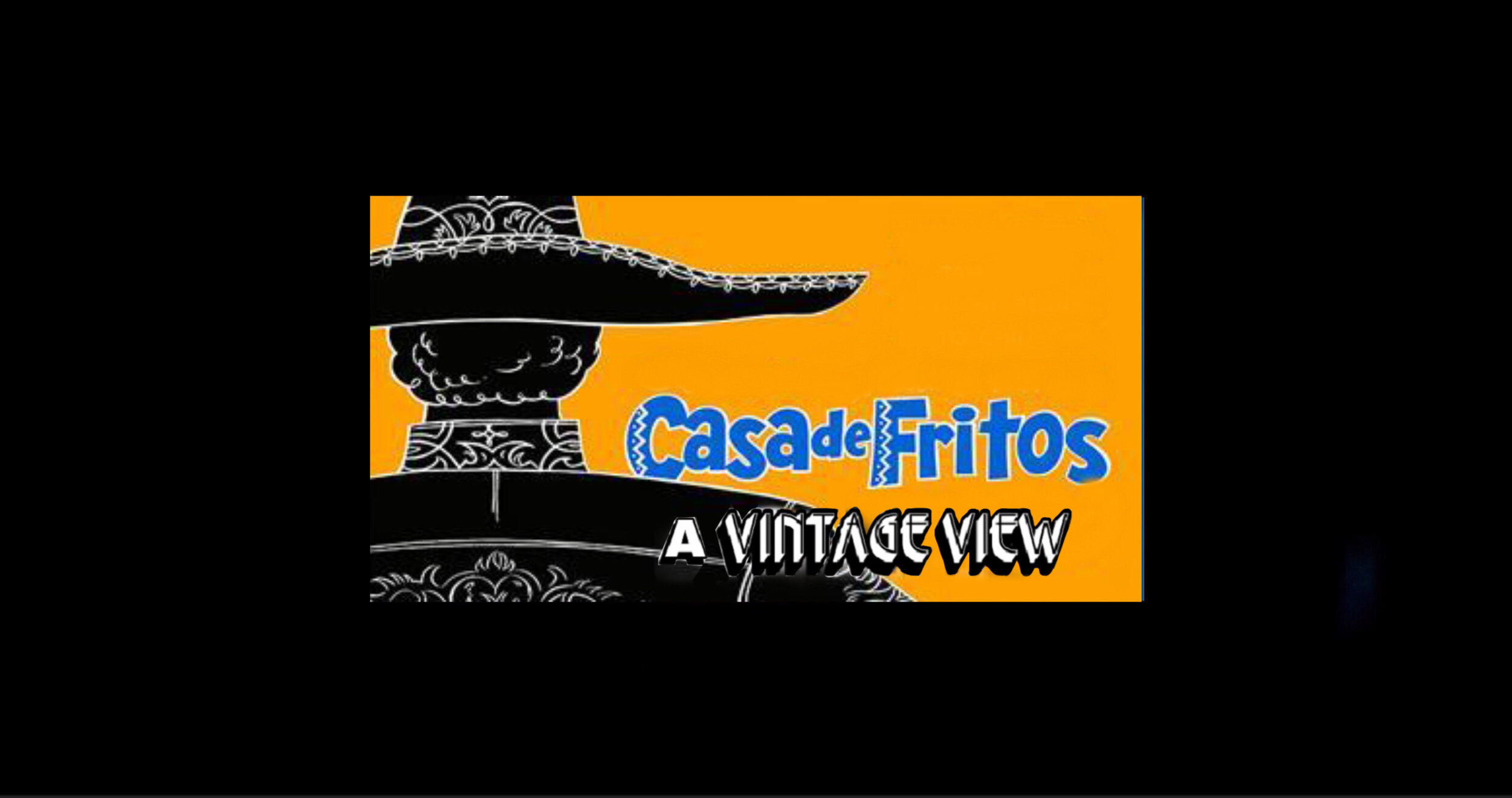CASA DE FRITOS (THE CASA MEXICANA) & FRITO HOUSE
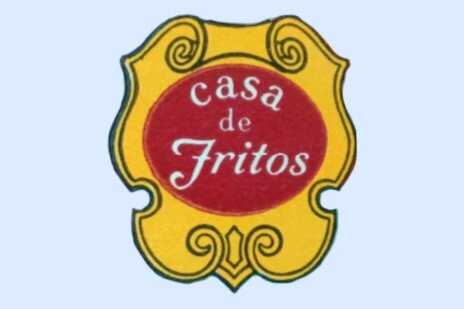
Casa de Fritos (August 11, 1955 - 1982)
“The Search for Disneyland Participant Sponsors”
Back in 1951, Walt Disney and Art Linkletter visited the famous entertainment complex Tivoli Gardens in Copenhagen. He was researching and talking notes to build a family entertainment center and Tivoli was much like what he envisioned. It was clean, directed to the entire family, fun, entertaining and educational. Walt noted how important it was to have a lot of places for guests to sit down and a wide variety of eating spots that served excellent meals.
During 1954, Walt was searching for participants to lease shop and restaurant spaces and help generate the necessary capital to fund construction of Disneyland® Park. In a synergistic relationship, the companies (in turn) could sell their products and advertise their corporate names in the Park. Disneyland Participant Corporate Sponsors were carefully selected. High quality, long term corporate sponsors would provide incremental income that enabled Disneyland to enhance its show and attractions, offset some operating expenses, and capitalize on marketing opportunities.
Several Disneylanders were essential to the establishing friendly relationships between sponsors and Disneyland. “55er” Rima Bruce (who started with Jim D'Arcy in Food when all food was Lessee and typed memos and menus) recalled that “the phone never stopped ringing with everybody trying to get a food lease in the Park.“ By July of 1954, Raul Grizante of Disneyland, Inc. was overseeing food philosophy, area & location, food specialties, and beverages for Disneyland. Individuals like Nat Wyncoff provided the essential orientation for curious lessees, selling them on the idea of Disneyland using various visual aids like sketches and one of Herb Ryman’s oil paintings of Disneyland.
Soon, “a cross-section of American industry…[was] represented in Disneyland. Each of these companies… [would expose] its institutional advertising and public relations message to Disneyland guests through various forms of participating exhibits and displays. In each case, the exhibit… [was be] related to the theme of the ‘land’ in which it is located, and is woven into the overall concepts and themes of Disneyland”, according to “Disneyland, U.S.A.”, published 1958. Several of these “reliable old firms” sponsored the “abundance of restaurants devoted to pleasing all tastes and all budgets,” according to “The Story of Disneyland”, published 1955. Frito-Lay became one of those forty-seven Disneyland Participants and lessees to sign a contract with Walt Disney Productions (regarding Walt Disney’s Disneyland), and one of a few to invite guests to “dine at Disneyland!”
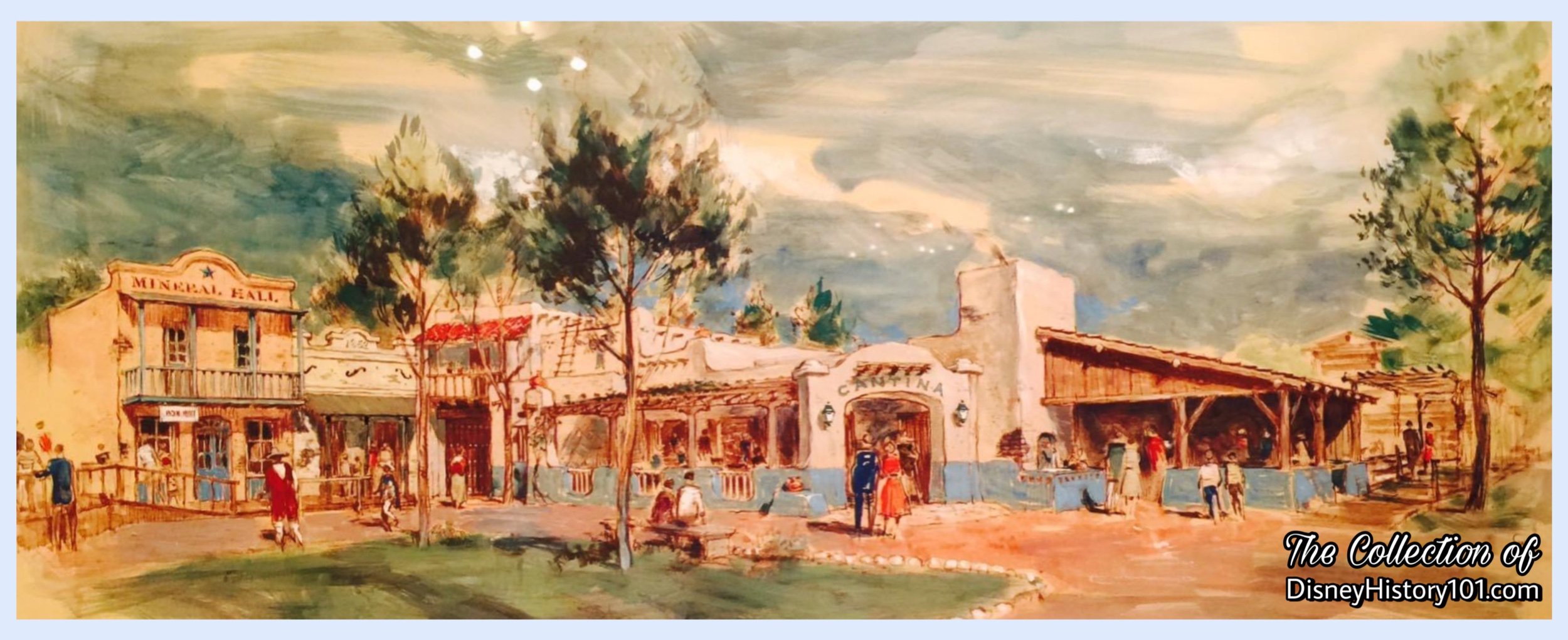
Casa de Fritos in the c. 1790-1876 Frontierland was styled with typical “south-of-the-Border” atmosphere.
Some of these viable project Concepts (as depicted above), were supported by a well-developed business case and built expectation.
“Blue Sky for Casa de Fritos”
According to “THE DISNEY THEME SHOW - an introduction to the art of Disney outdoor entertainment: Volume II”: “Of all the guests’ senses that come into play at Disneyland, the most difficult response to predict was taste. If 70,000 guests were to arrive on a single day, there would probably be 70,000 different ideas about food. Generally speaking, Disneyland food locations fall into three categories - sit-down restaurant service, ‘buffeteria,’ and fast-food categories.”
The most extensive theming has always been found in the sit-down restaurant locations but all locations were housed in authentically modified facilities. “Disneyland is unique in that some of the world's foremost creative artists and architects control all design at Disneyland.“ The Casa de Fritos building was styled with typical “south-of-the-Border” atmosphere.
“Architectural Designs by Lessees”
Disneyland, Inc. printed materials for Lessees detailing specifications for architectural designs of exhibit spaces. These were revised by March 16, 1955 and issued to Lessees.
All of the interior architectural drawings were done by competent registered architects or an approved display house of the lessee's choice. All of the designs submitted by the lessee's architect, whether for buildings or construction of interiors in DISNEYLAND, were approved as to the theme and general plan of DISNEYLAND as established by WED Enterprises, Inc.
Three sets of preliminary drawings were furnished DISNEYLAND, Inc. as soon as possible after signing of the lease. Two sets were retained by DISNEYLAND and one set was returned to the lessee’s architect with any revisions noted thereon and stamped “APPROVAL TO PROCEED TO FINAL DESIGN.” This stamp when properly signed and dated constituted the lessee’s authority to proceed with the final drawings.
The Lessees revised their final drawings to incorporate any revisions noted on the approved preliminary drawings, and submitted three sets of the revised drawings to DISNEYLAND. One set was returned to the lessee’s architect and any revisions noted thereon are to be incorporated on the original drawings. When the lessee had incorporated the final revisions on the drawings, two sets of transparent ozalids were forwarded to DISNEYLAND for approval. DISNEYLAND would stamp both sets “FINAL DESIGN APPROVED” and “LESSEE’S CONTRACT DRAWINGS”, and return one set to the lessee who could then release drawings for bid and/or construction.
“Construction”
“F. M. Franz, manager of operations for McNeil Construction expressed: "We feel sure there has never been anything built like this in Southern California, or elsewhere in the United States. Many of the items were constructed from artist’s sketches.”
Casa de Fritos would be situated directly opposite the Dixieland Gazebo Bandstand. All fixtures were placed in their correct motif and many light fixtures were authentic antiques.
As of June 2, 1955, C.V. Wood Jr. sent an Inter-Office Memorandum to Walt Disney regarding the best estimates that could be obtained at the time regarding the completion status of individual sections of the Park and Opening Day. C.V. wrote: “Fritos: They will be able to open with us but the part with the little animated man may not be complete.”
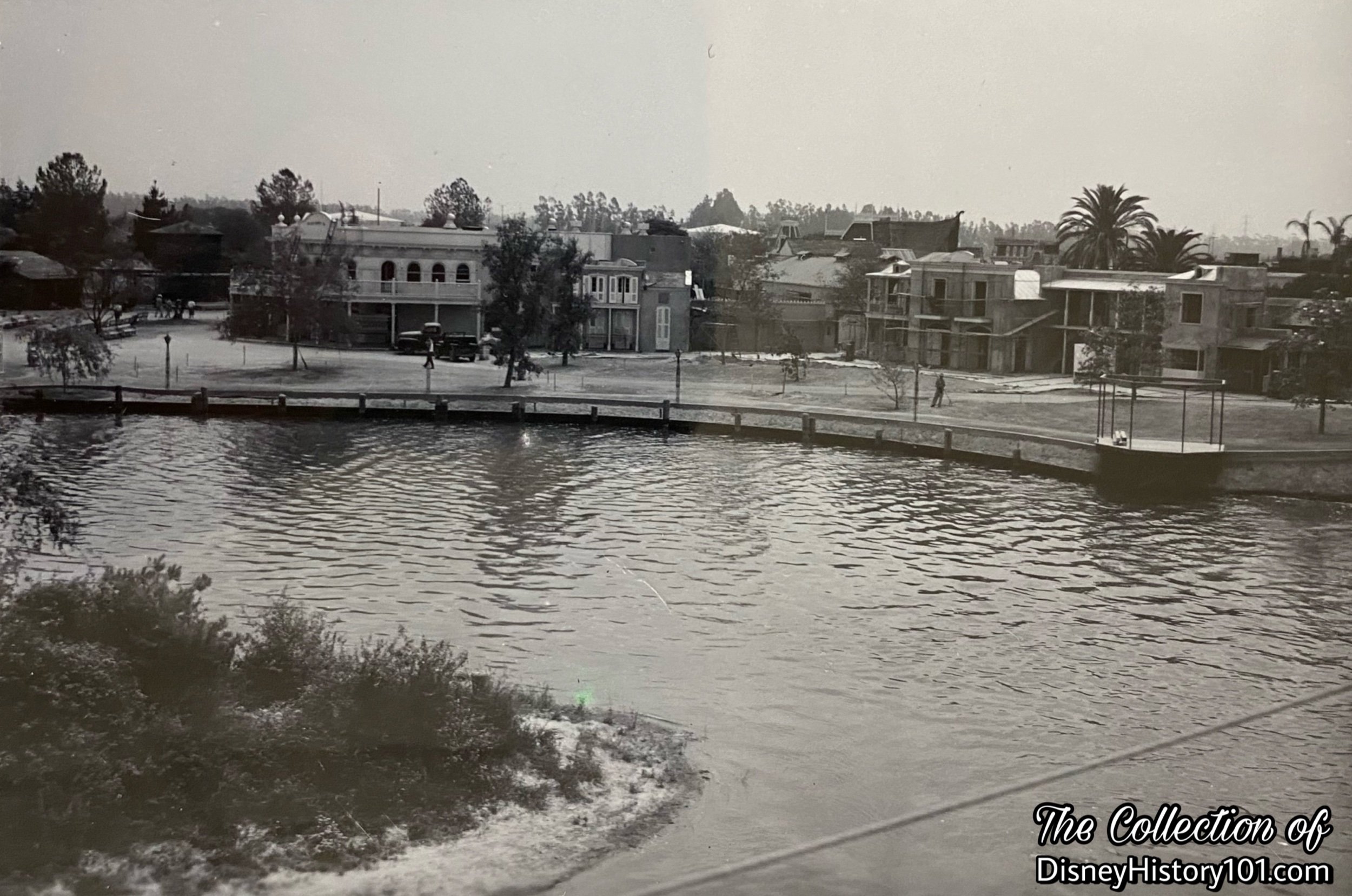
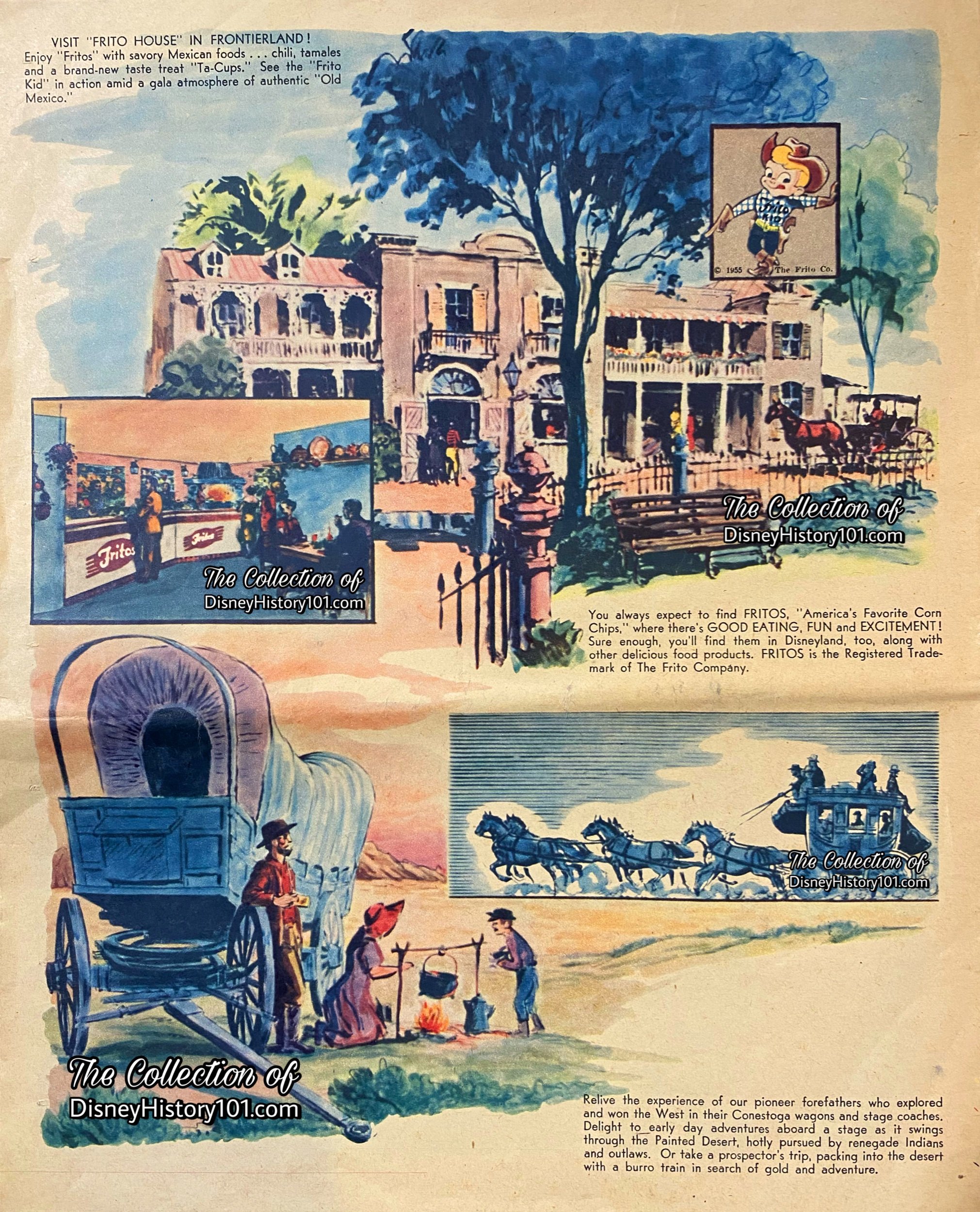
An Advertisement for Casa de Fritos in the “Disneyland” Excerpt published June 15, 1955
“Grand Opening of Casa de Fritos”
Two days before the televised Press Preview event at Disneyland, a (c. June 15, 1955) newspaper supplement whet the public’s appetite by featuring a full page advertisement of Casa de Fritos. The Santa Ana Register, July 15, 1955 briefly described the location as “an authentic Mexican Taco cafe and a Frito house.”
The Press Preview Day arrived. Then Disneyland opened to the general public on July 18th, 1955, but Casa de Fritos, the table service restaurant did not. It would be nearly one full month before Casa De Fritos (or, “The Fritos House”) opened on August 11th, 1955, in a small location near the water’s edge on the Rivers of America (not far from the current site of the River Belle Terrace).
Service was described as “efficient cafeteria style,” offering “indoor and outdoor dining facilities.” Here (overseen by Jim Baker of Disneyland, Inc.), Guests discovered “Mexican food specialties, combination plates, tamales, enchiladas,…, chips, chili and beverages” - “tantalizing dishes so popular south of the border.” According to the Disneyland News (June, 1956), “Chili is a house staple prepared and offered in a variety of intriguing combinations. Tamales, enchiladas, and an all time favorite of the Taco found in a unique ‘tacup’ round out the menu. For a meal that includes the variety of tempting flavors of all these the Frito chef recommends the Mexican Combination Plate.” Of course, guests can expect to find Fritos (“America’s favorite corn chips”) where there’s good eating, fun, and excitement! In addition (and in a move of corporate synergy), the Frito House was one of 16 Disneyland “eating places” which featured “fine food with fine coffee - Maxwell House,” from 1955 to 1957! Carnation Farms would also serve this and 14 other wholesale customers who operated restaurants and snack bars in Disneyland.
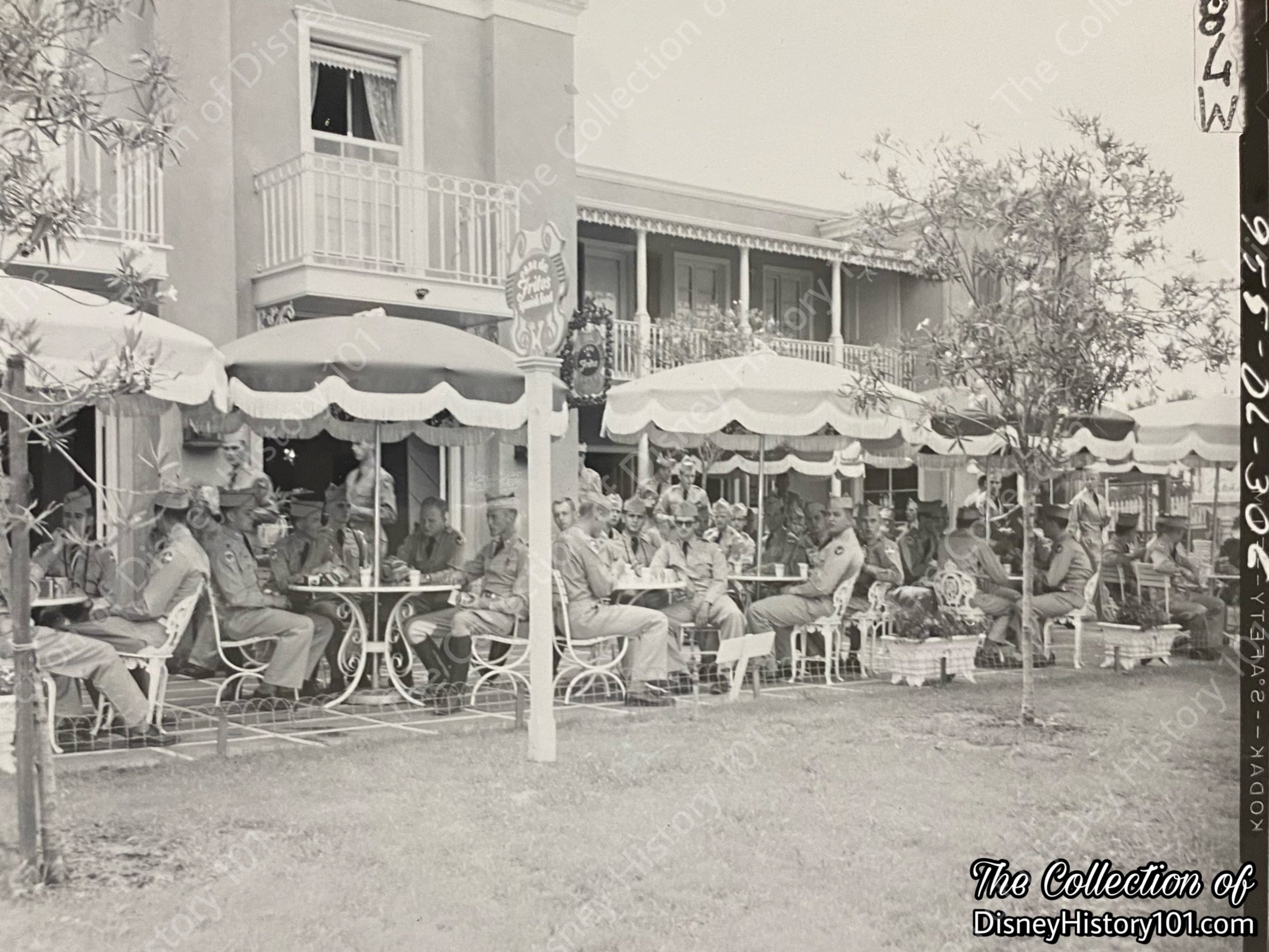
The original location of Casa de Fritos.
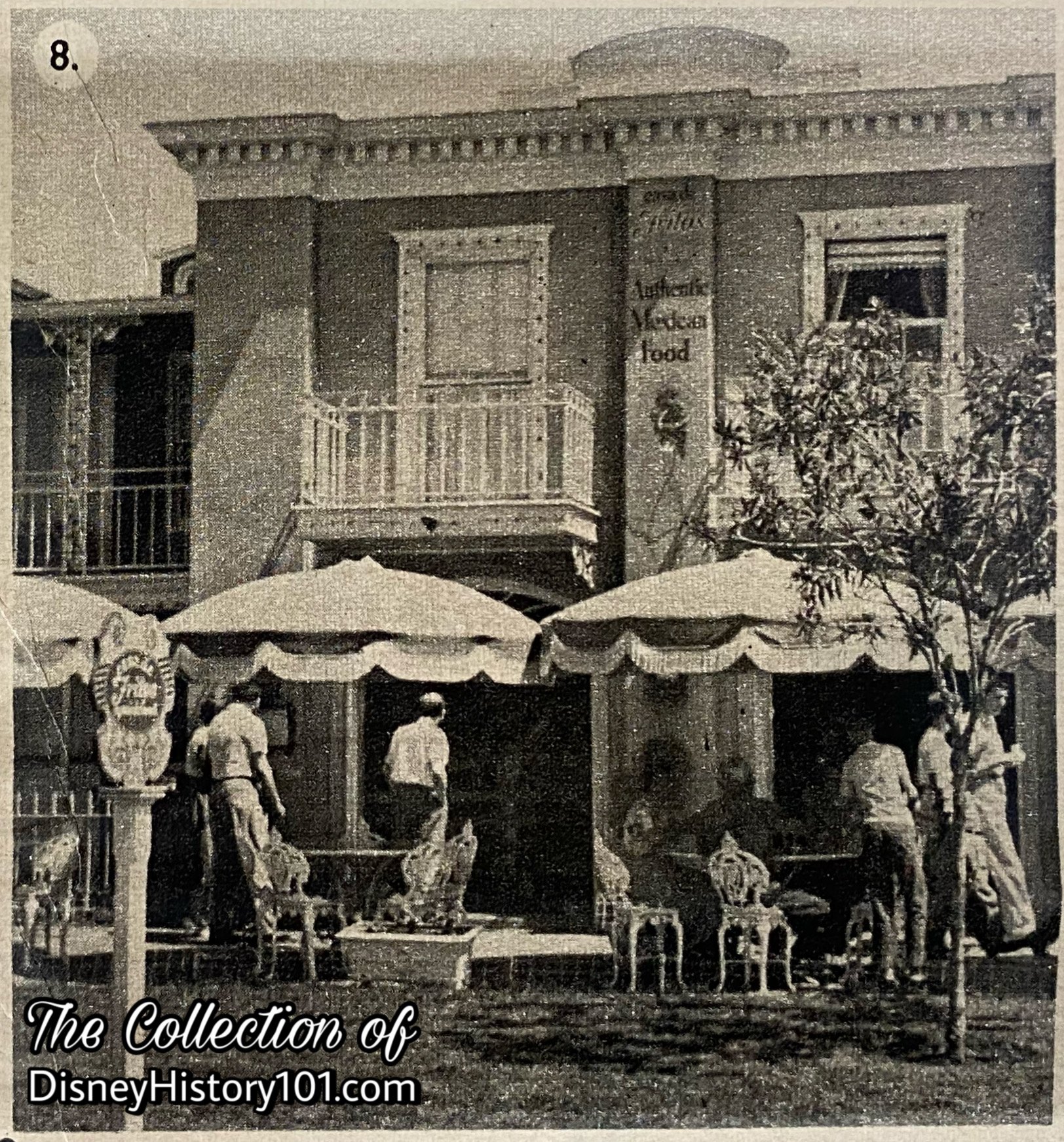
The original Casa de Fritos location and Architectural Facade was notably seen in the “Disneyland 1st Anniversary Souvenir Pictorial”
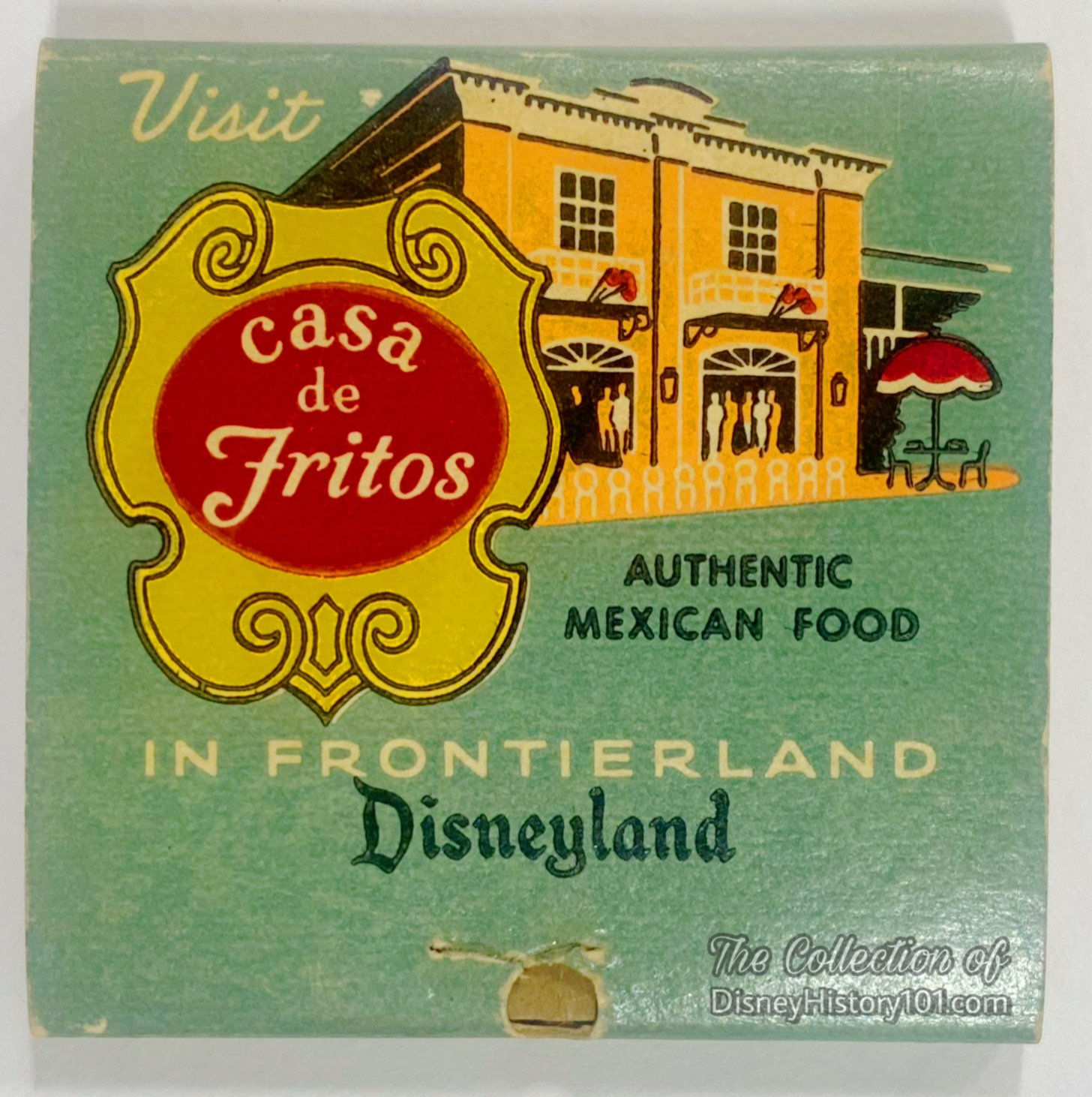
An early Casa de Fritos matchbook depicting the first location.
This matchbook was a tangible memory for Guests.

An early Casa de Fritos matchbook with matches touting the menu.
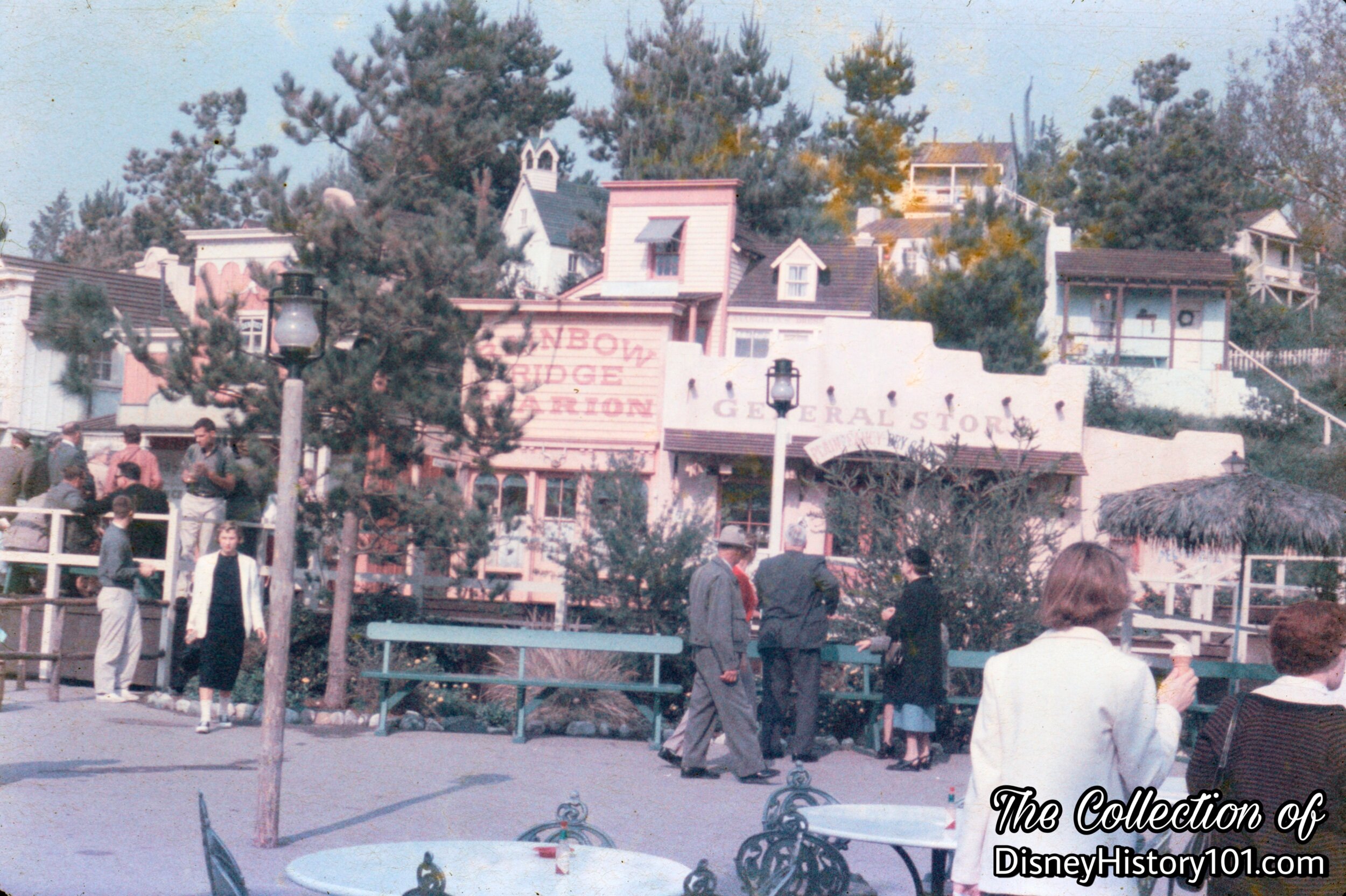
Casa de Fritos Patio, (1950s)
“The Move of Casa de Fritos”
Walt Disney, on the eve of Disneyland’s first day of operation, promised that “Disneyland will never be completed. It will continue to grow, to add new things, as long as there is imagination left in the world.” A half year later, at a meeting of the Disneyland Merchant's Association (held January 25, 1956), a momentous announcement was made: “Me may move Fritos over to the opening of the Mine Ride to service with Mexican food, etc. The service roads are being changed to go between Frontierland and Fantasyland without coming down through the park.” Soon, Casa de Fritos restaurant was closed and relocated to another area, replacing the Marshal’s Office in Frontierland (and not far from Disneyland Offices tucked away in an adjacent Backstage area). In place of its former location, Don DeFore’s Silver Banjo Barbecue opened its doors for a five year lease, but that’s an entirely different story.
The area was further embellished. By September 28, 1958, Disneyland, Inc. made approximately $20,551.00 of land improvements to the Mining Town Restaurant.
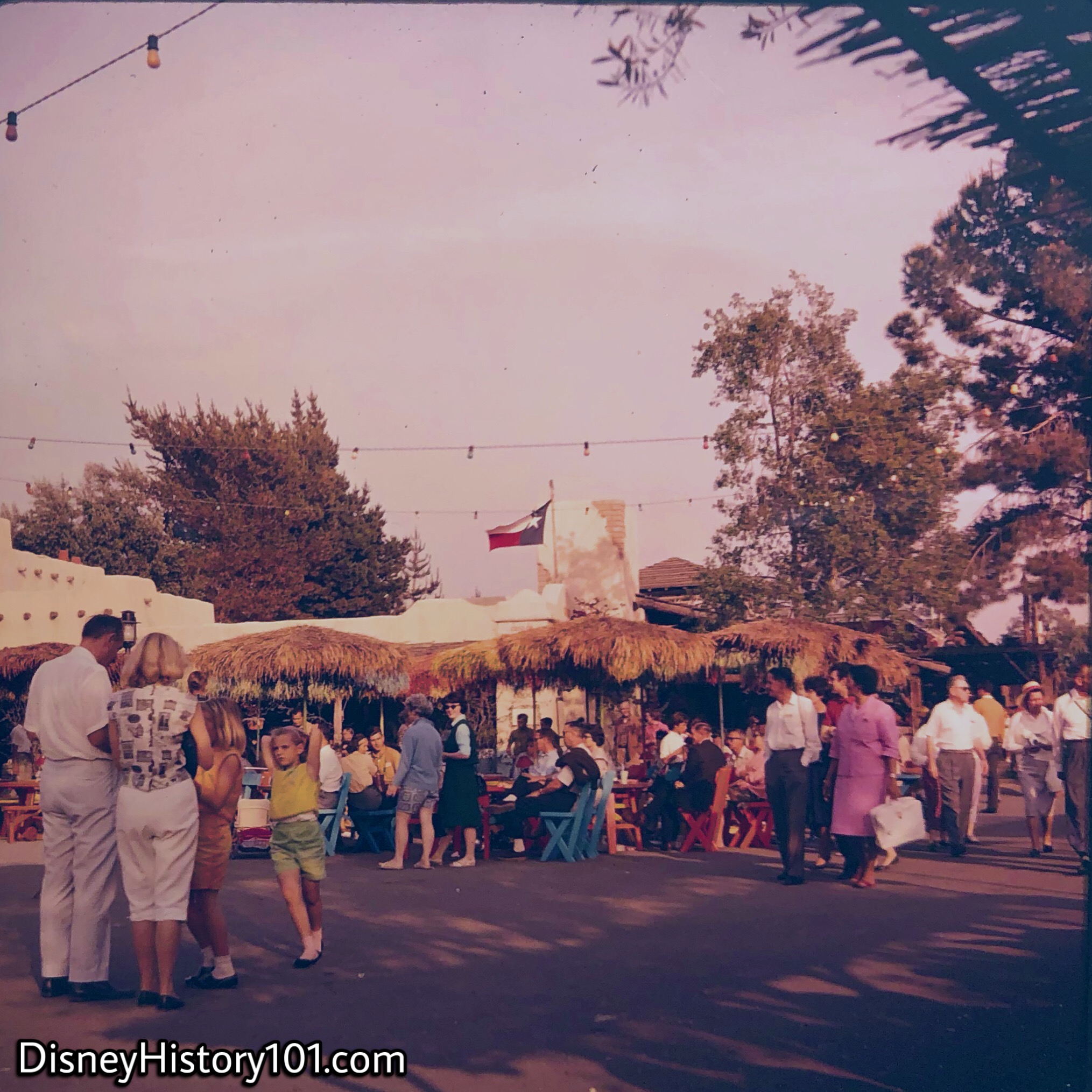
Casa de Fritos at Mealtime
Casa de Fritos soon became one of three major attractions in Frontierland’s El Zocolo. The new Show Building setting was an “adobe and thatched shade,” structure according to the “Disneyland Dictionary,” compiled by WED Enterprises, Inc. and WED Public Relations Department, c. 1968. Appropriately, the Lone Star Flag flew over Frontierland’s “Tex-Mex” dining destination, while the patio was routinely packed with hungry guests. This was generally the scene around mealtime.
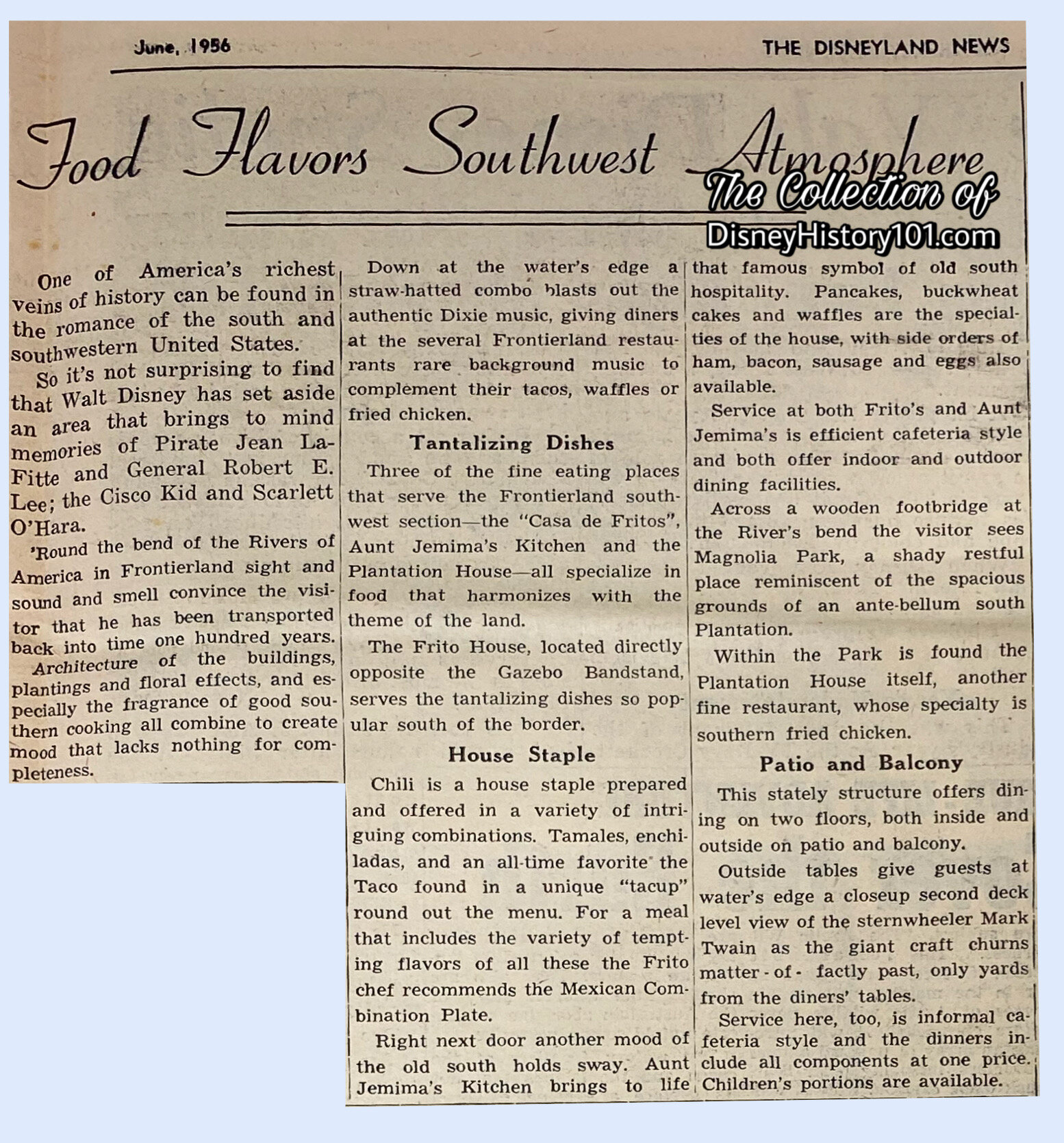
The Disneyland News Excerpt, (June, 1956)
“Projections and Response”
It was predicted that Casa de Fritos operated by Fritos Company would have the capacity to serve 450 guests per hour. This particular Disneyland eating facilities was predicted to contribute to accommodating “15,000 persons daily, hitting a peak of 60,000 on holidays and week-ends…” and one of “twenty restaurants and snack bars, capable of saving 8,000 hourly,” at least according to “Building A Dream” (prepared by the Disneyland, Inc. Public Relations Department).
As a result, Disneyland, Inc. received much income. For example, in 1958, Bank of America appraisers figured of the total income received from leases, 16.02% was derived from the selling of advertising rights and 40.12% from the leasing of space to concerns whose main reason for occupancy is for advertising purposes. The remaining 43.86% of the lease income was derived from stores that sell various products and food.
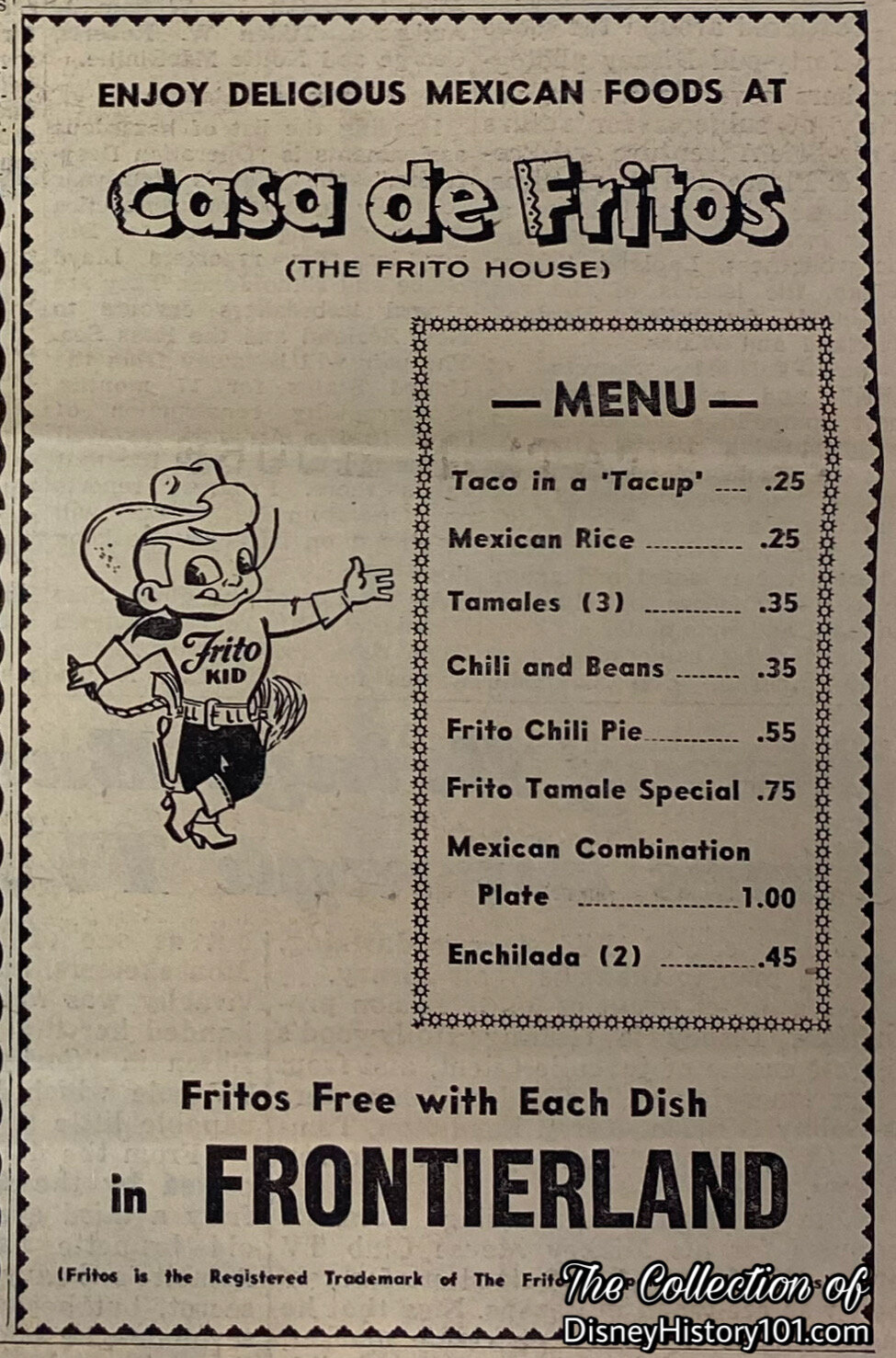
Disneyland News Casa de Fritos Advertisement Excerpt, June, 1956.
During the era of their Disneyland “Participantship”, servings of Fritos were offered free with each dish at Casa de Fritos, and also available à la carte via Vendors near the entrance. The “Ta-Cups” (a taco in a cup-shaped shell) were advertised in pre-opening advertising supplements of The Disneyland News in 1955!
In a move of synergy, the Frito Co. contributed food to the First Annual Disneyland Christmas Party on December 10, 1956.
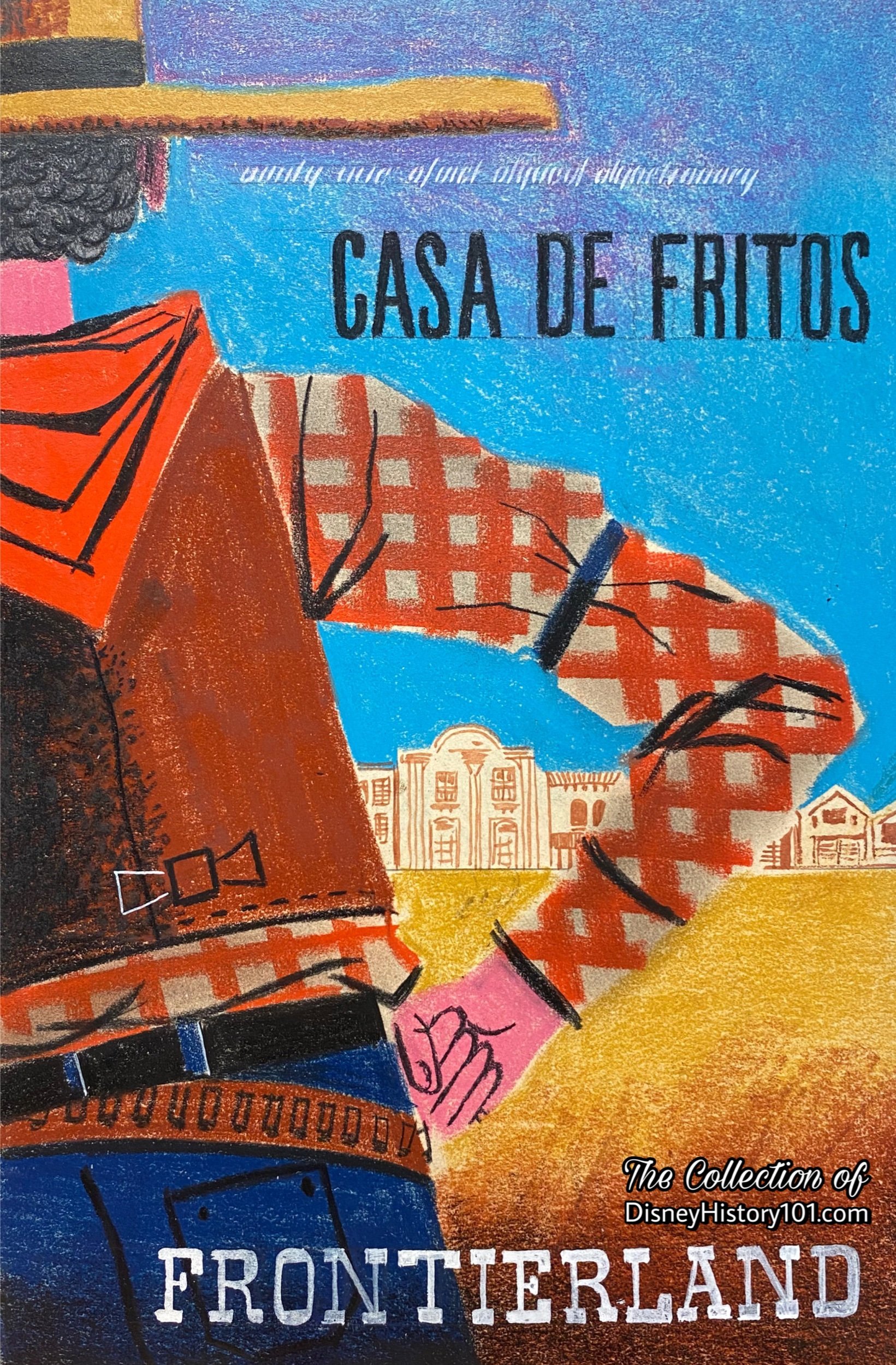
Casa de Fritos poster art by an unknown artist.
While Disneyland needed no introduction, its attractions did! At Disneyland, signs and posters were themed to support the stories with respectful graphics, colors, fonts, terminology, the overall design of sign, materials (wood, metal, banners, etc.), and verbiage used on the signage.
When the earliest attraction posters were prepared, Casa de Fritos also received a promotional poster. By this time, all art work, posters, etc. were produced at the Walt Disney Studios. According to “Disneyland Attraction Posters: 40 Years of Visual Adventure” by Margaret Shumate, published in Walt Disney Collector Society “Sketches” periodical: “With his usual attention to every detail of his beloved park, Walt Disney personally reviewed and approved each finished piece of poster art until his death in 1966.”
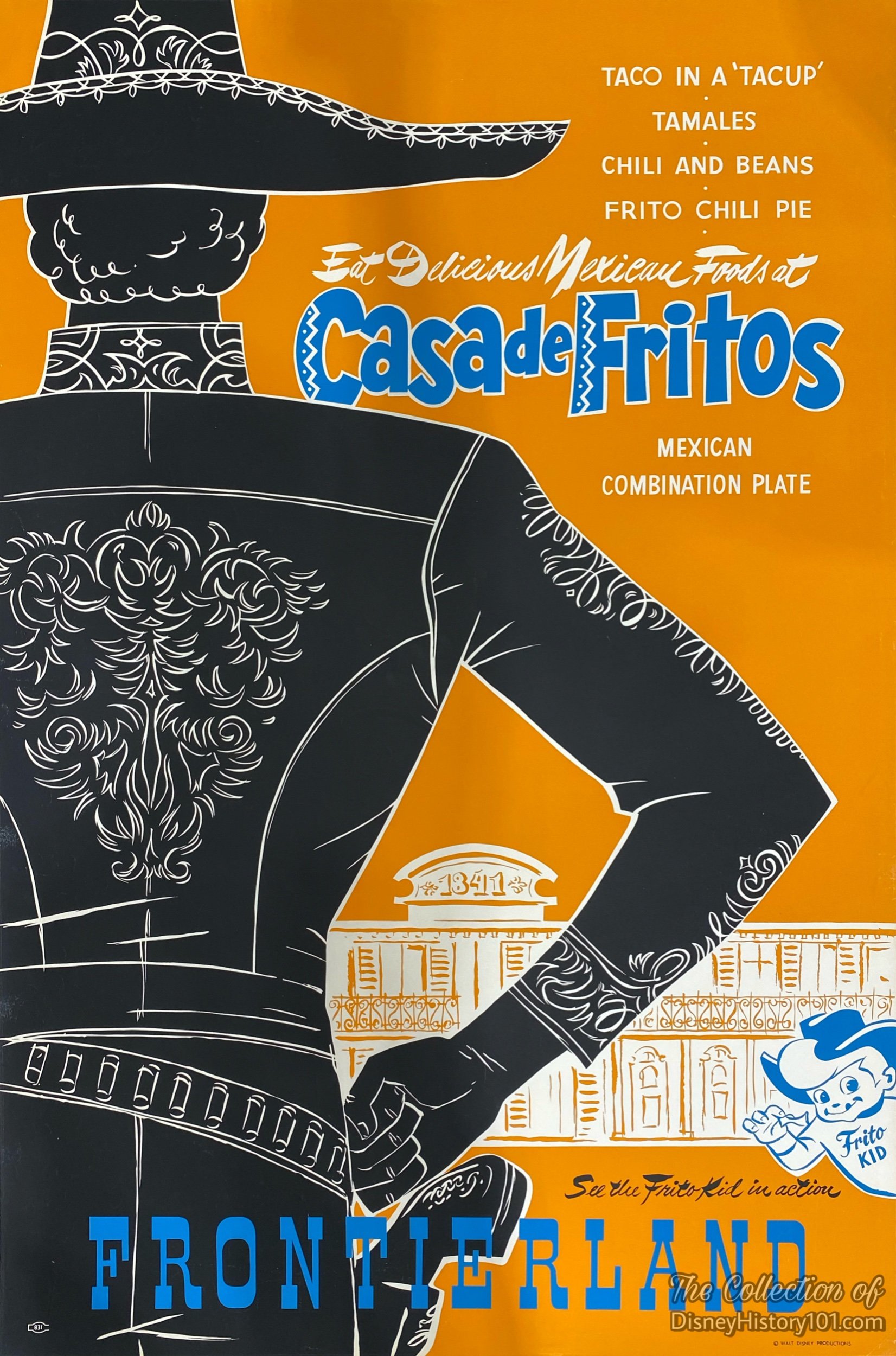
Casa de Fritos Disneyland Park® poster art by Bjorn Aronson.
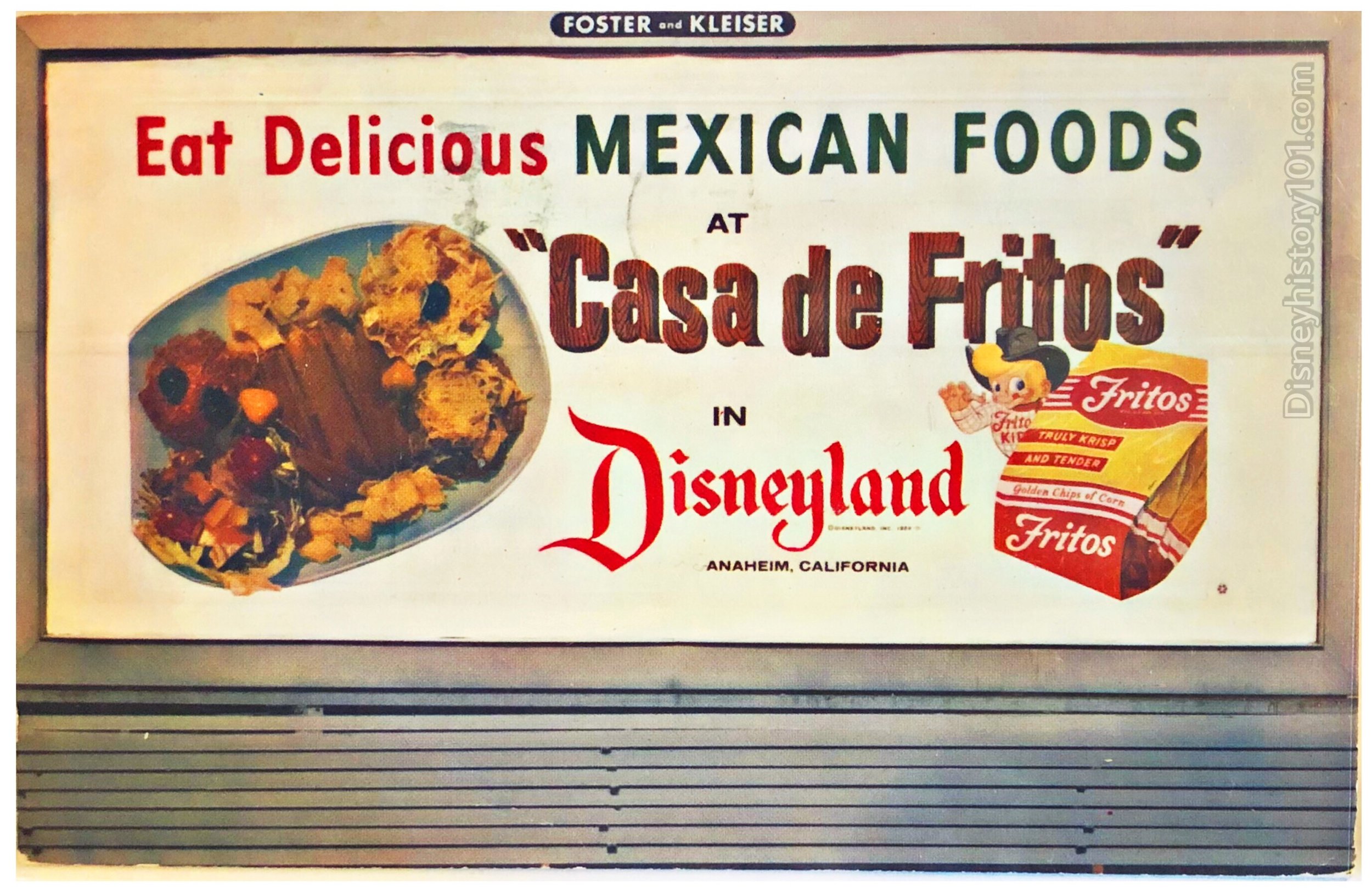
Casa de Fritos Promotional postcard, c. 1955 - 1958.
This Casa de Fritos promotional postcard that was sold inside Disneyland featured the artwork of the Casa de Fritos billboard image which advertised the restaurant to locals passing just outside Disneyland.
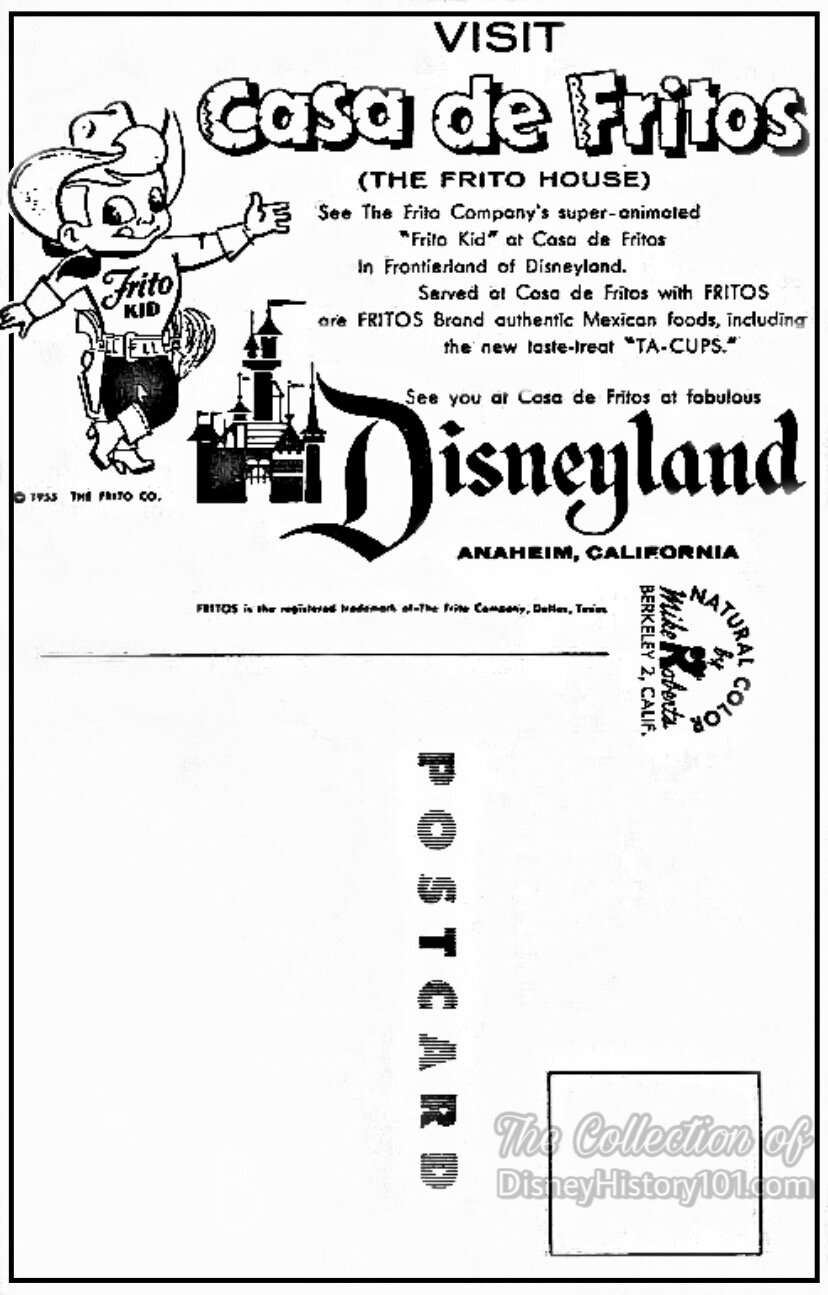
Casa de Fritos Promotional postcard (c. 1955 - 1958)
The synergistic relationship between the institutional lessee and Disneyland was beneficial. The Frito Company yielded some revenue for Disneyland Inc. - $18,831 for the fiscal year ending September 29, 1957 and $21,263 for the fiscal year ending September 28, 1958.
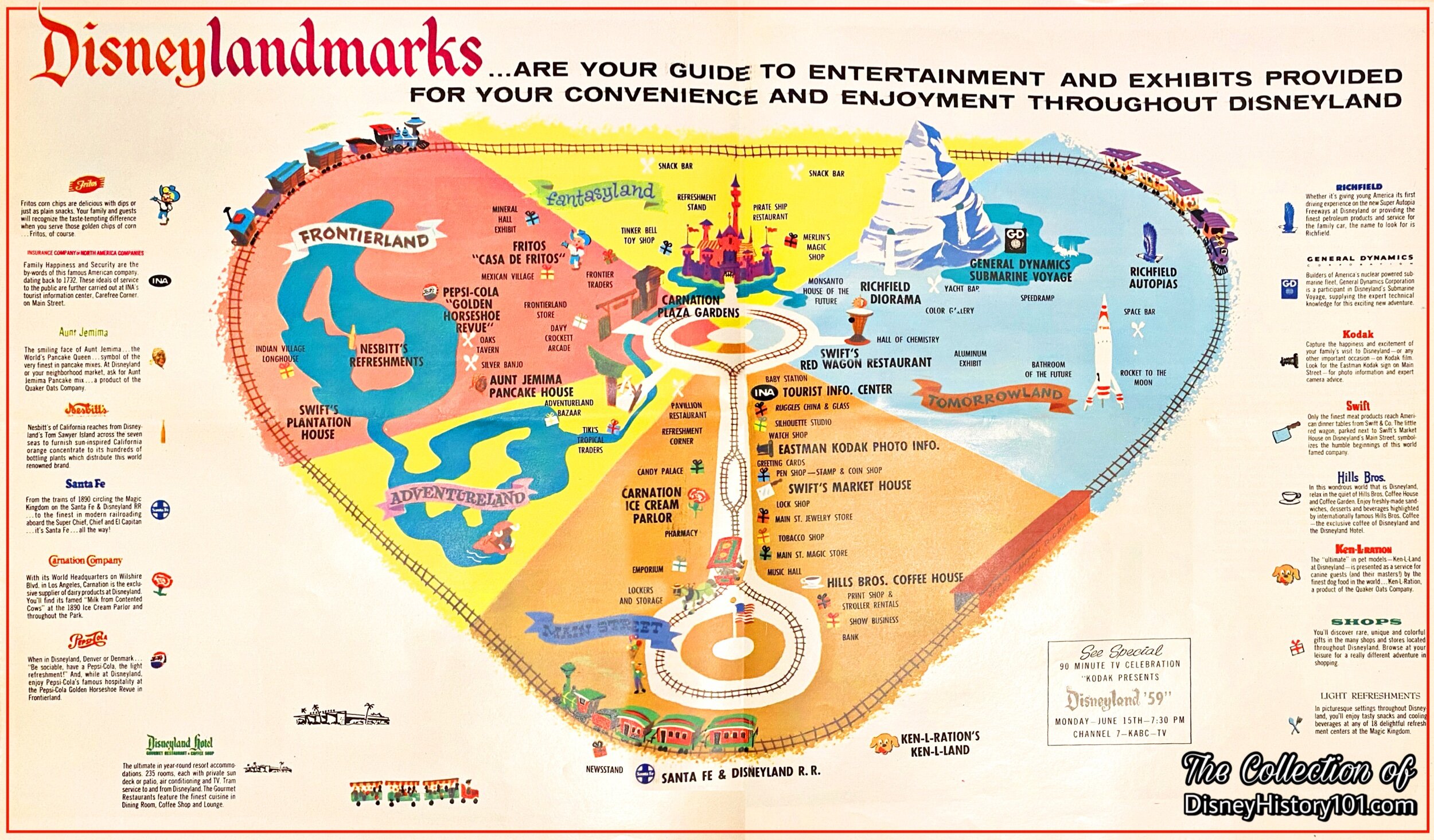
“Casa de Fritos and the ‘Second Opening’ of Disneyland and Beyond”
Owning to Jack Sayers (of Lessee Relations), Casa de Fritos was a contributing Participant of Disneyland ‘59! By October of 1959, the company was (1) of over sixty-eight other firms playing a vital part in the team effort to bring happiness to Disneyland’s Guests. Some were small, specialized individual operators; some were huge companies such as Swift & Co. - the Bank of America - United Paramount Theaters (which you hear as UPT) - Carnation - Richfield - General Dynamics - Crane - and many others. These companies used the park to publicize their wares, leased space in the Park to sell their wares, and Disneyland collected advertising fees from them.
As a sidelight, by October 1959, Jim Baker (of Merchandising) was overseeing the Disneyland Souvenir Sales and Food Administration which included Casa de Fritos.
By 1960, Disneyland wasn’t the only theme park with a Frito Company Mexican Restaurant. Freedomland had a Old Southwest restaurant sponsored by the Frito Company.
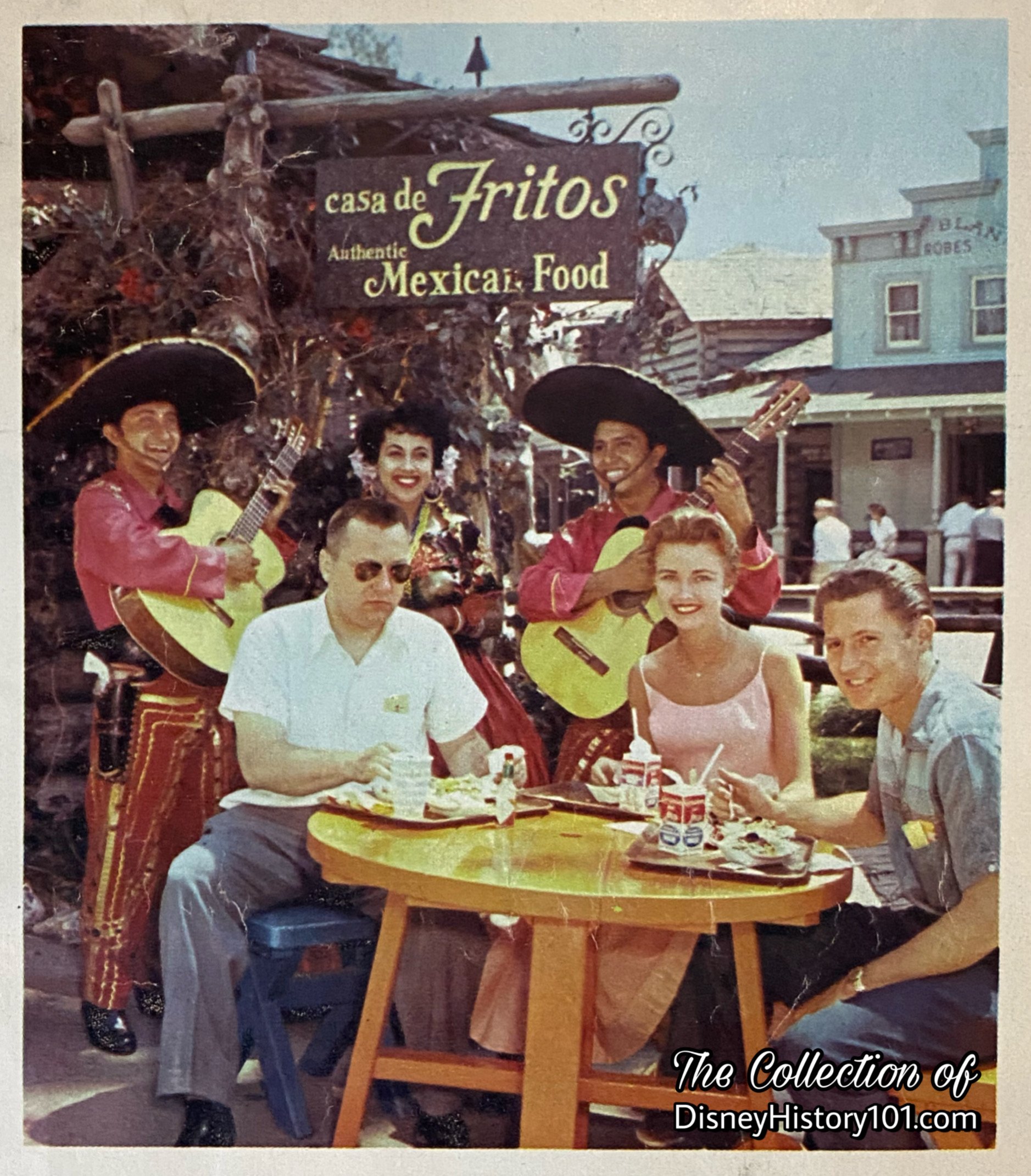
Gonzales Trio at Casa de Fritos as seen in “Disneyland Summer ‘59” Supplement Excerpt.

Casa de Fritos Patio, (1959)
The Casa de Fritos featured outdoor seating on the patio. Tables and guests were shaded by grass-thatched umbrellas, and guests sat on colorful red, blue, green, and yellow benches while dining.
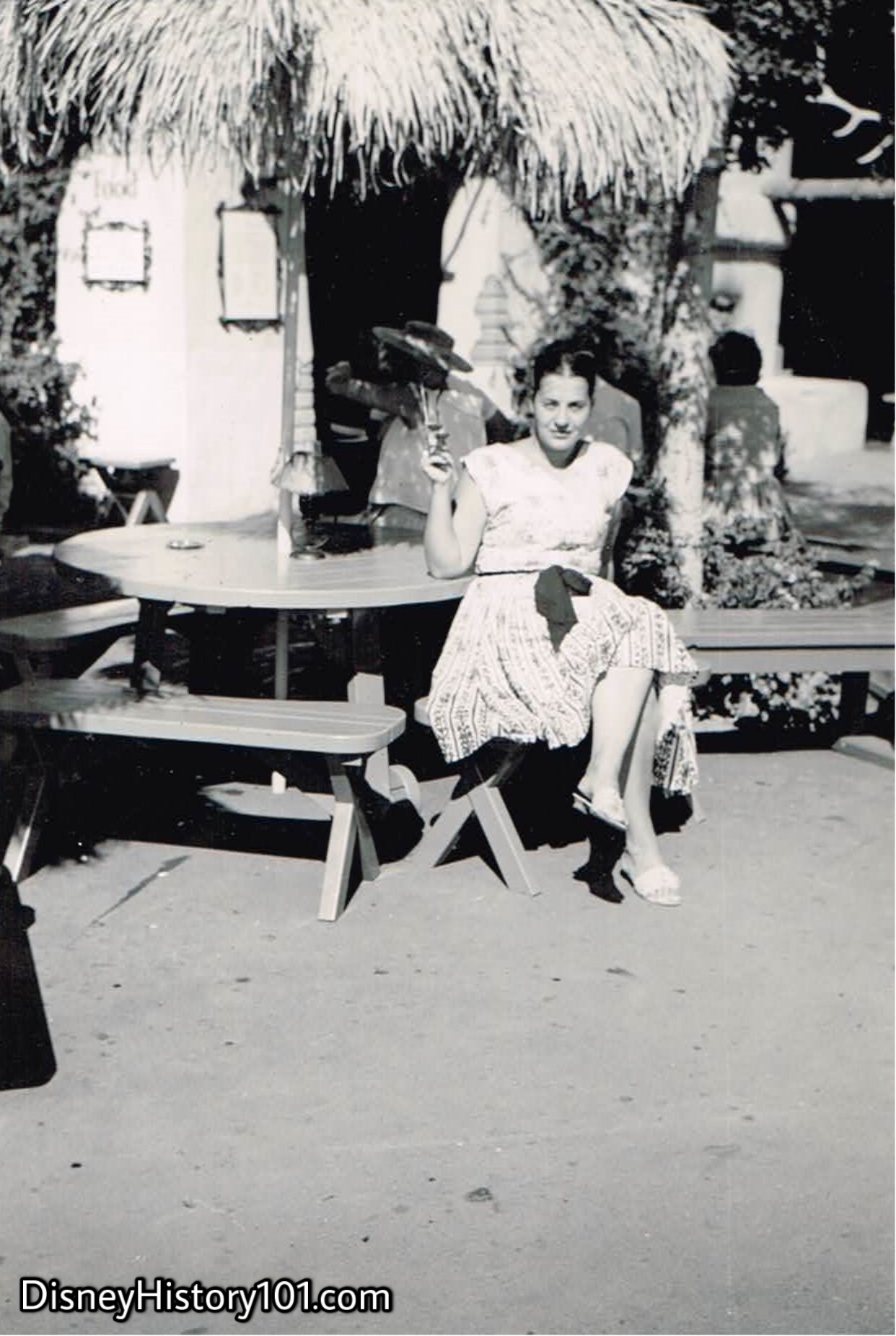
A Disneyland VIP enjoys the Casa de Fritos Patio, June 1960.
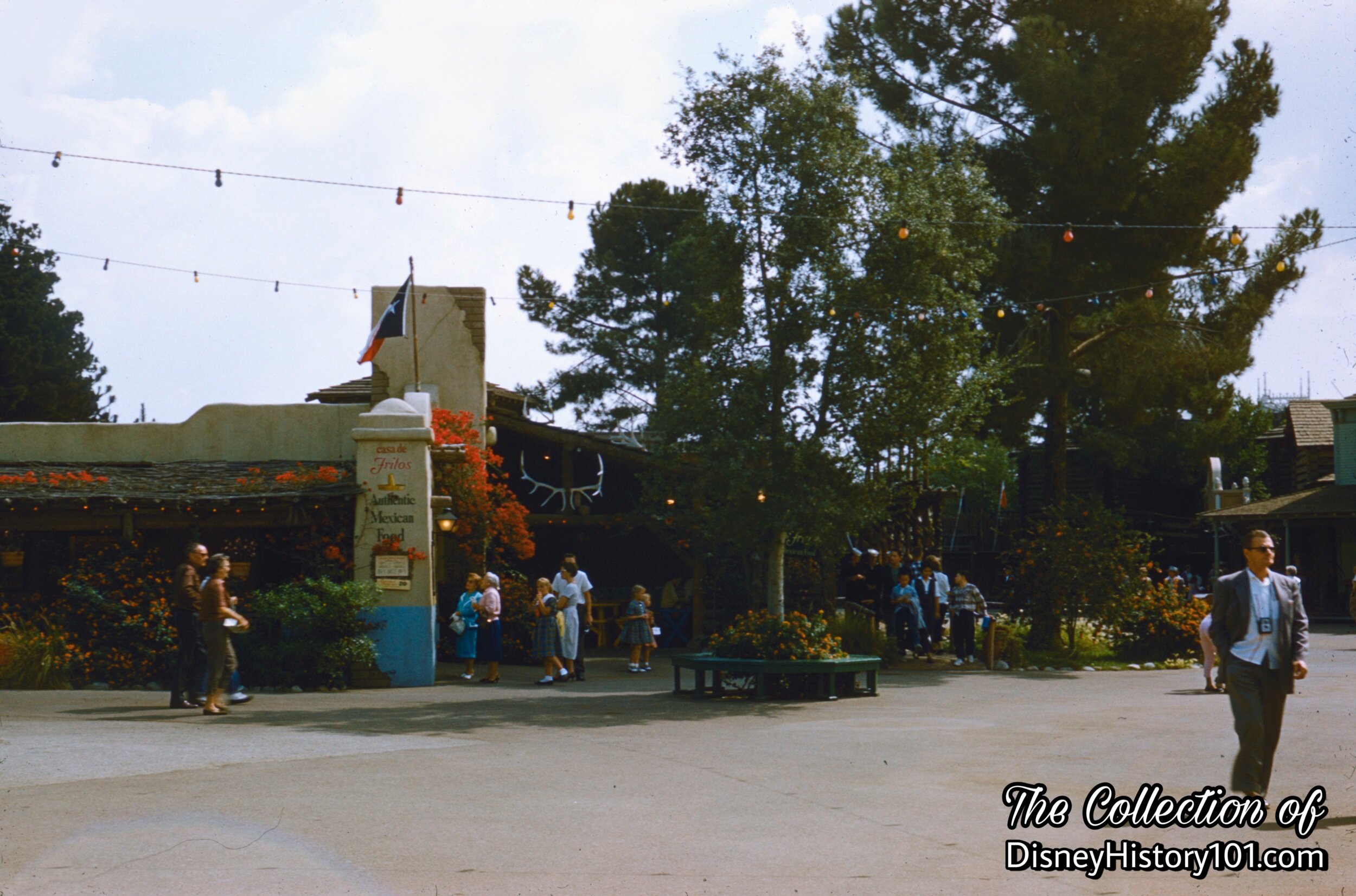
Casa de Fritos, October 1961.
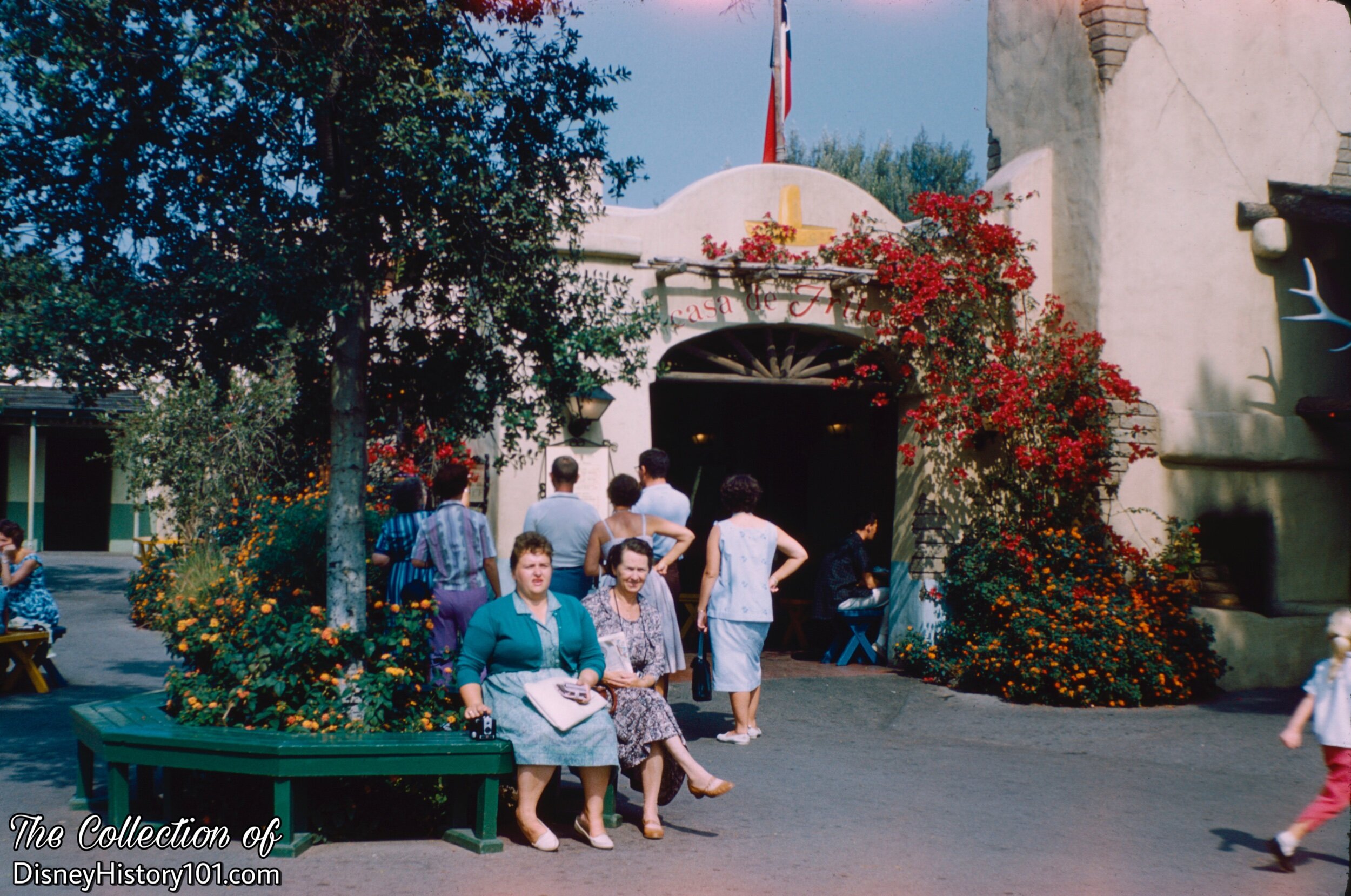
Casa de Fritos Entrance, (October, 1961)
When the indoor dining room was full, guests sometimes waited for available tables while seated on the benches around this planter.
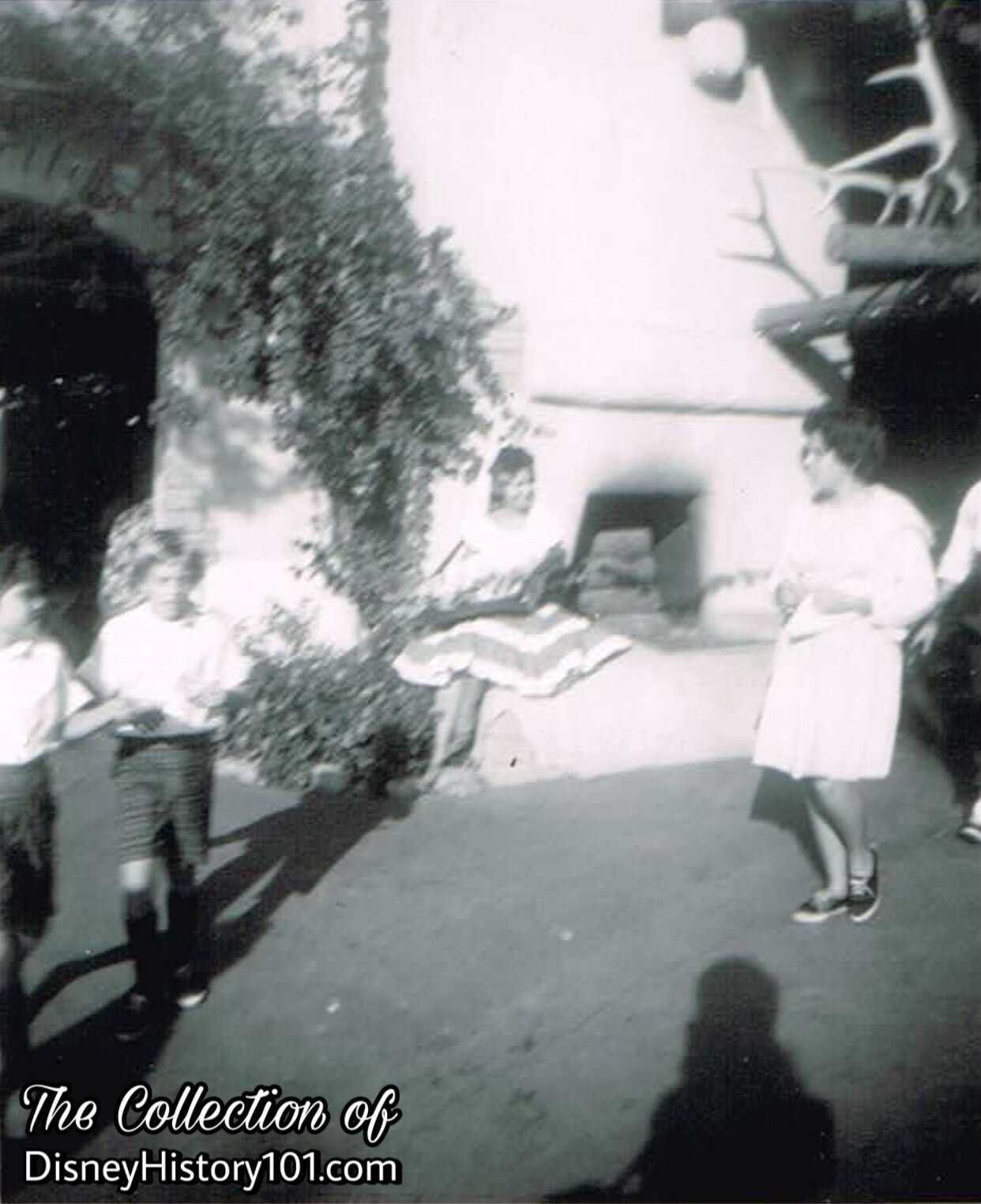
Fritos Vendor on Casa de Fritos Hearth, (October, 1962)
You may be wondering who this “chip-a-dee” is? As mentioned earlier, if you were in the mood to munch a quick snack (and not a meal), Fritos were also sold by the female vendors that would typically be found sitting on the old Blacksmith Shop hearth, located just outside the Casa de Fritos.
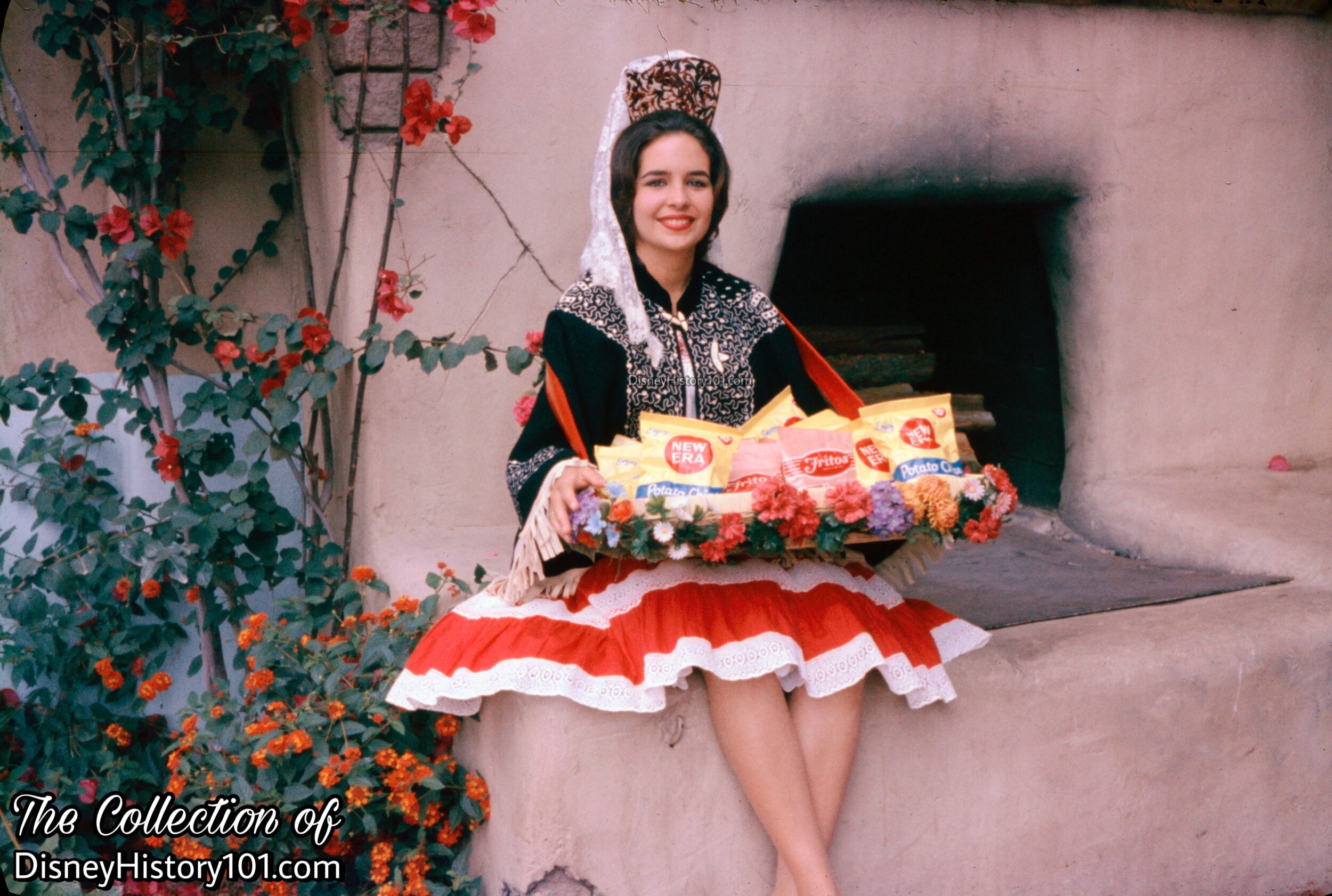
Fritos Vendors extended a courteous smile in a unique Greeting Area in Front of House, June, 1963.ik
“Any Food Or Drink Tastes Better With Fritos”
Guests were encouraged to “try Fritos with sandwiches, hamburgers, soups, salads, hot dogs, Mexican foods, and your favorite beverage”! You may have personally had the experience of eating a bag of Fritos with a refreshing Welch’s Grape Juice or a cup of Carnation Farms’ milk at Disneyland. Here, the Fritos Vendor Hostess (like Alice Rodriquez) exemplified the spirit of Disneyland while selling popular Fritos corn chips (straight from Klondike) and New Era Potato Chips.
As a sidelight, New Era Potato Chips was acquired by Lays, and ultimately Pepsi-Co. in 1965. New Era soon began distributing a certain thicker “Ruffled Chip”, specially designed with grooves for dipping (which can be seen among the vendor’s offerings, pictured above).
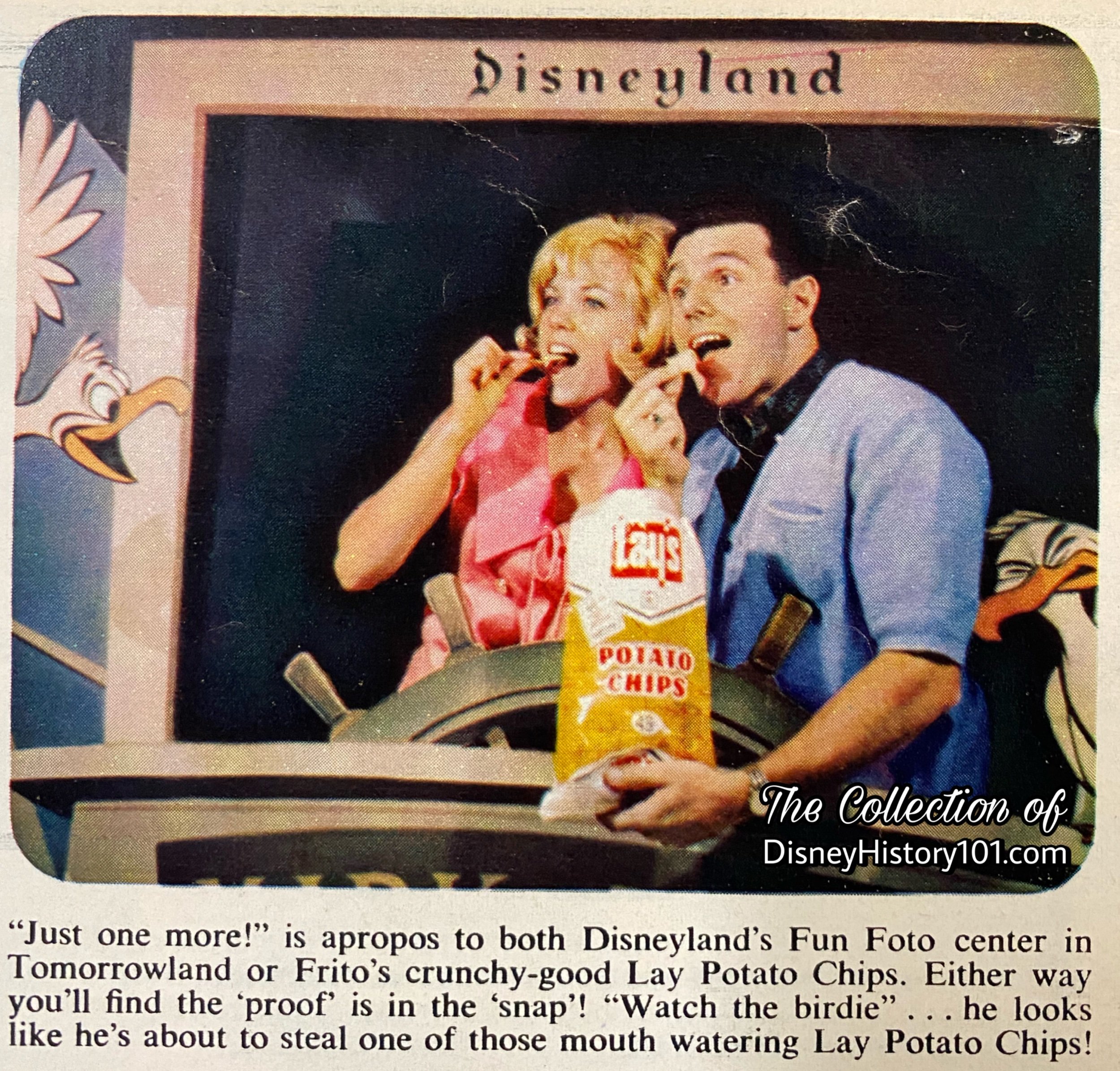
Guests enjoy Lays Potato Chips at “Disneyland ‘65 Tencennial Celebration” Supplement Excerpt.
In 1967, the price range for meals ran from 30¢ to $1.85.
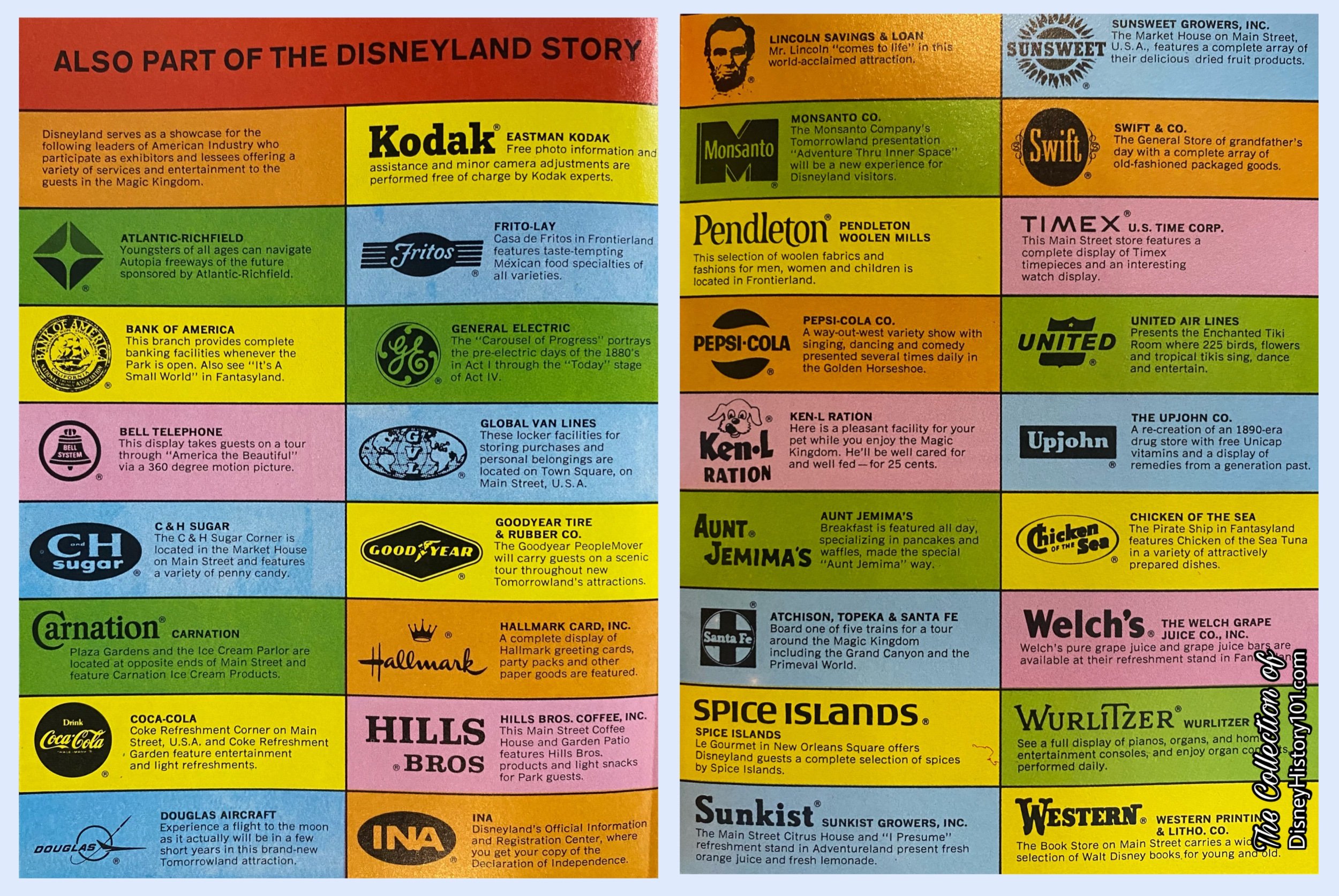
Fritos was a Disneyland Participant and thus “part of the Disneyland story according to this “Disneyland ‘67” Excerpt.
From May 7 to May 20, 1973 the Casa de Fritos was closed for a 2-week rehabilitation.
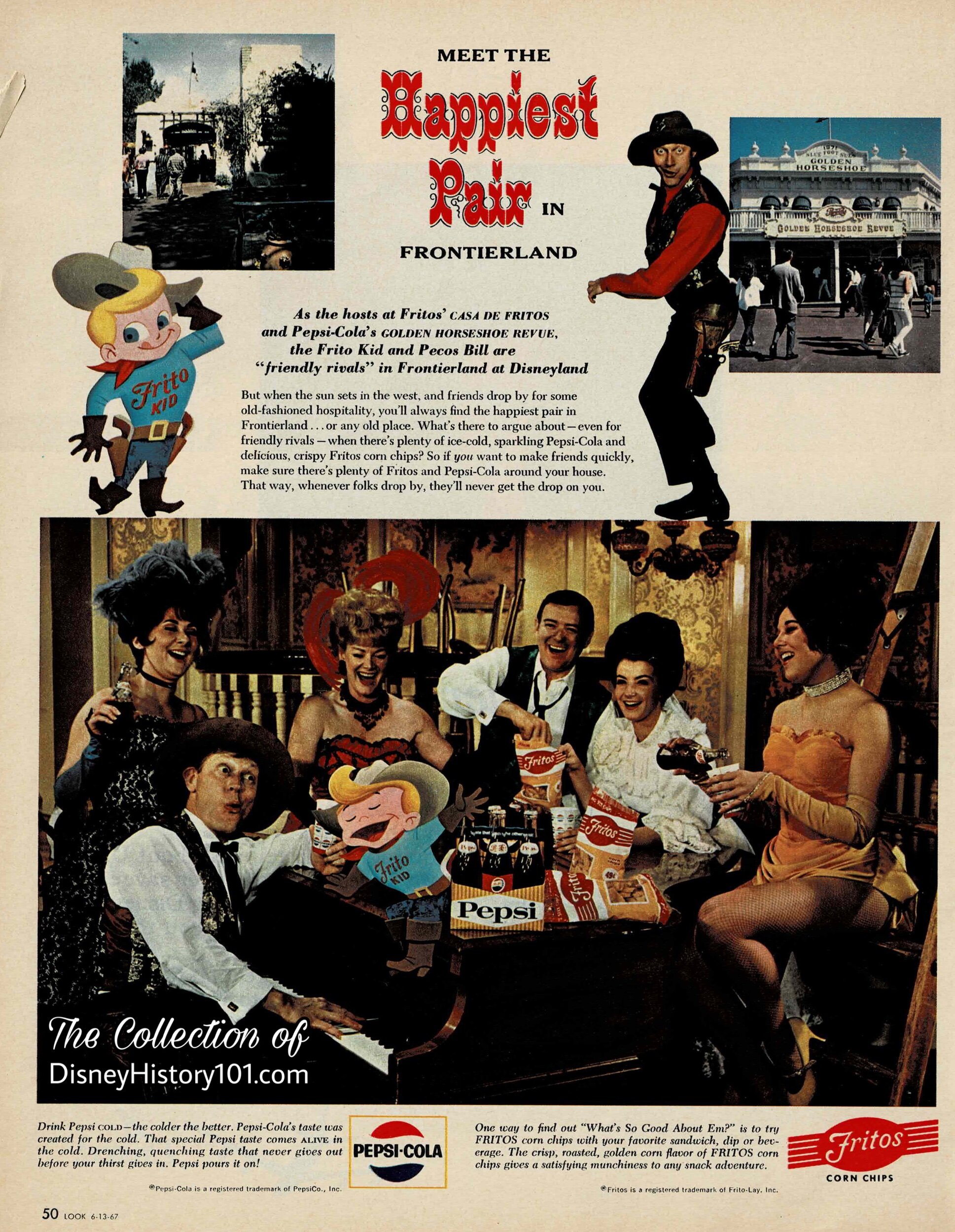
Fritos Advertisement Starring Wally Boag, The cast of The Golden Horseshoe and The Frito Lay Kid
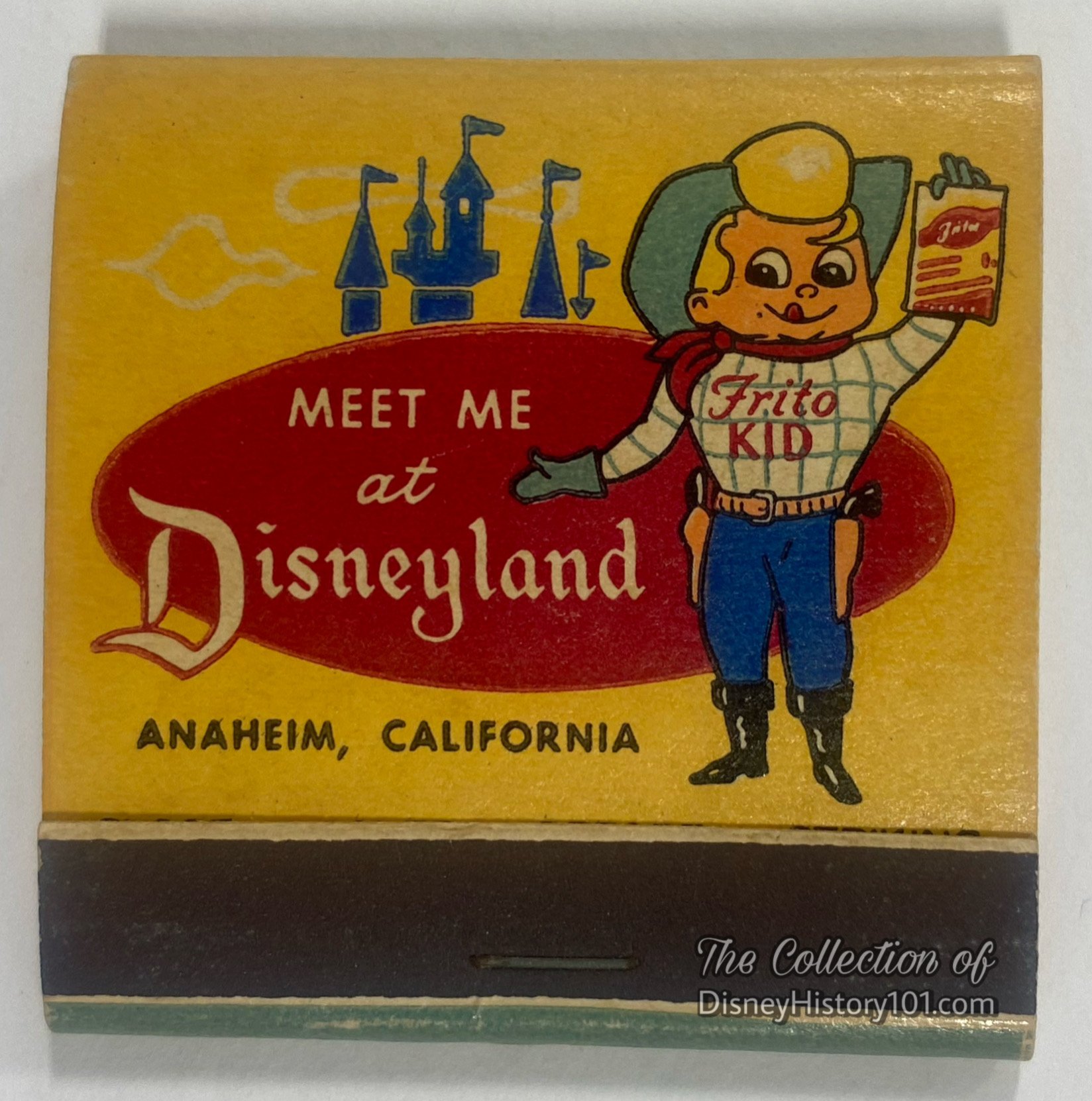
Casa de Fritos matchbook cover featuring the Frito Kid.
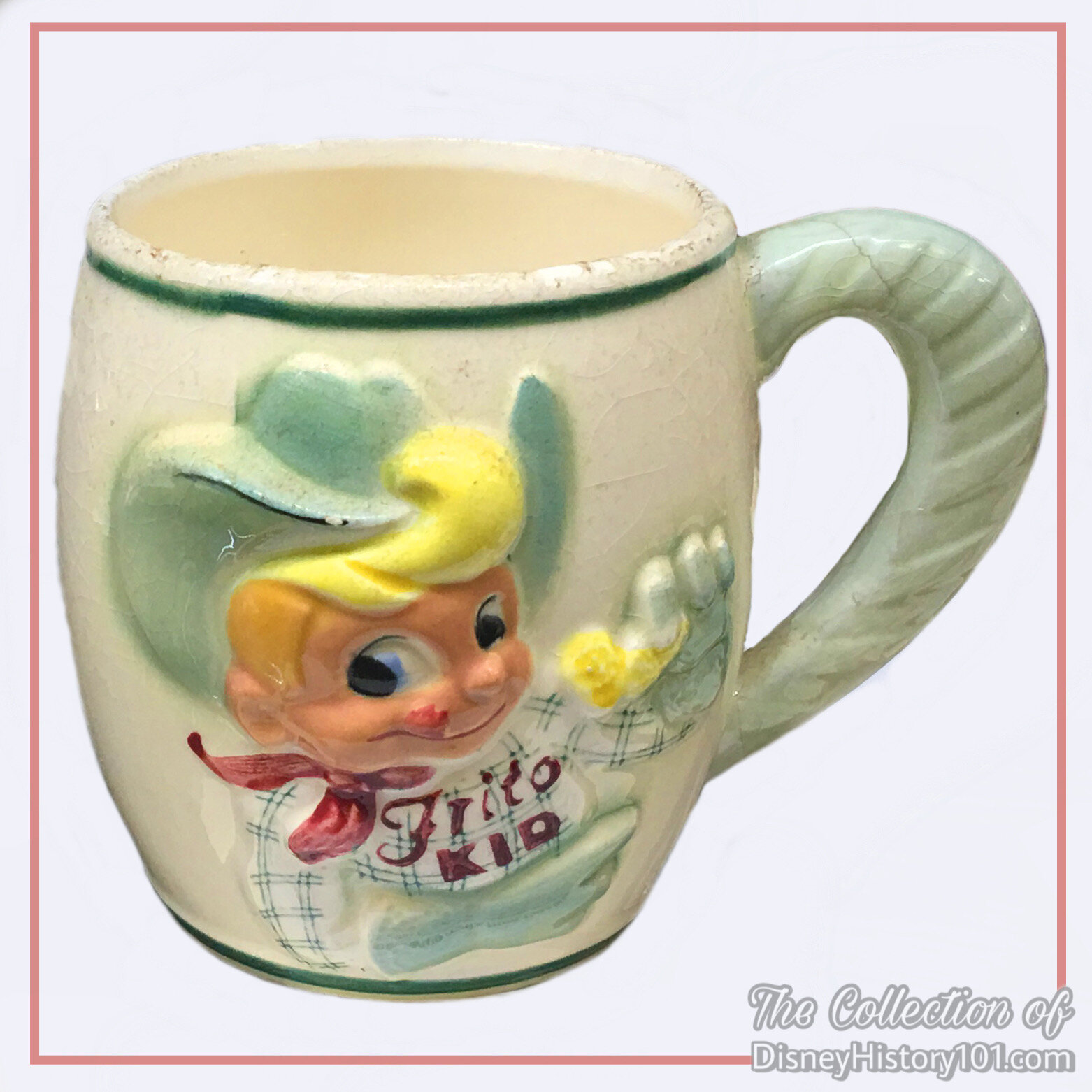
The Frito Kid Souvenir Ceramic Mug, c. 1960’s
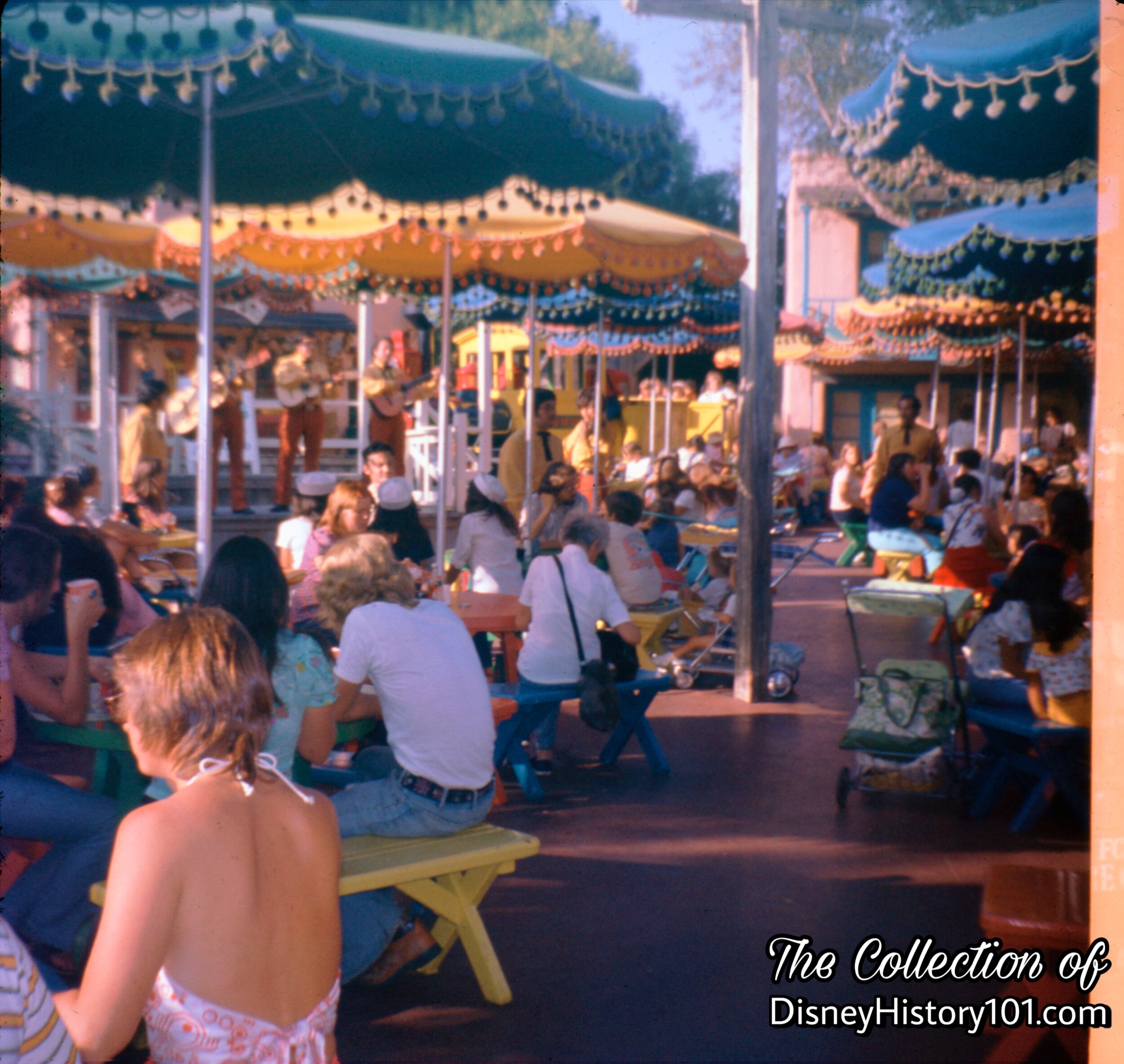
Casa de Fritos, September 1974.
During meals, the wandering mariachi would serenade diners as they refreshed themselves and ate under the festive umbrella-shaded patio tables.
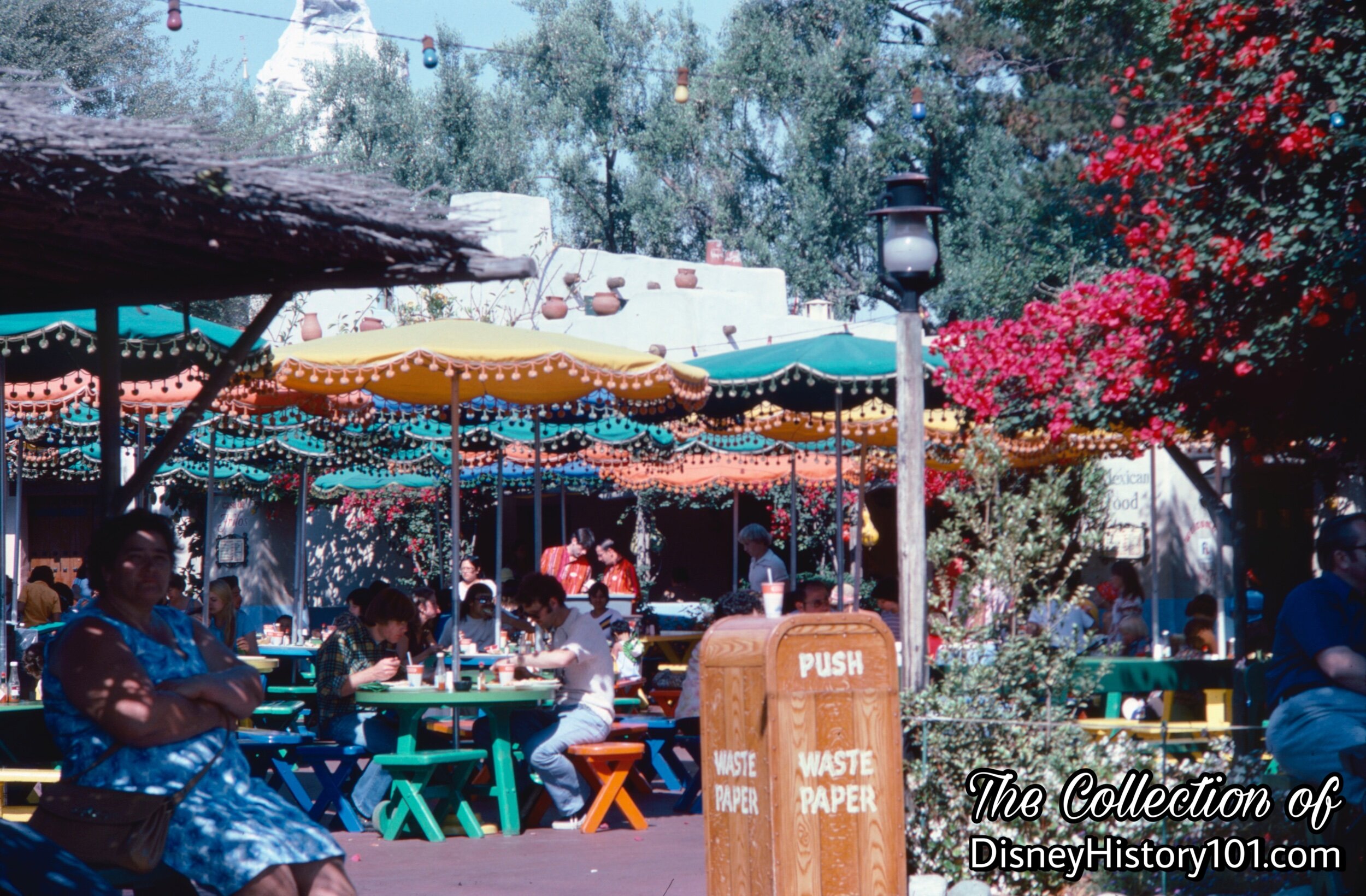
Casa de Fritos Patio, June 1978.
During 1978, a massive rehab came to Casa de Fritos (as well as the Frontier Gallery and Frontier Traders). This project was overseen by Lead Bud Poole (of Disneyland Maintenance).
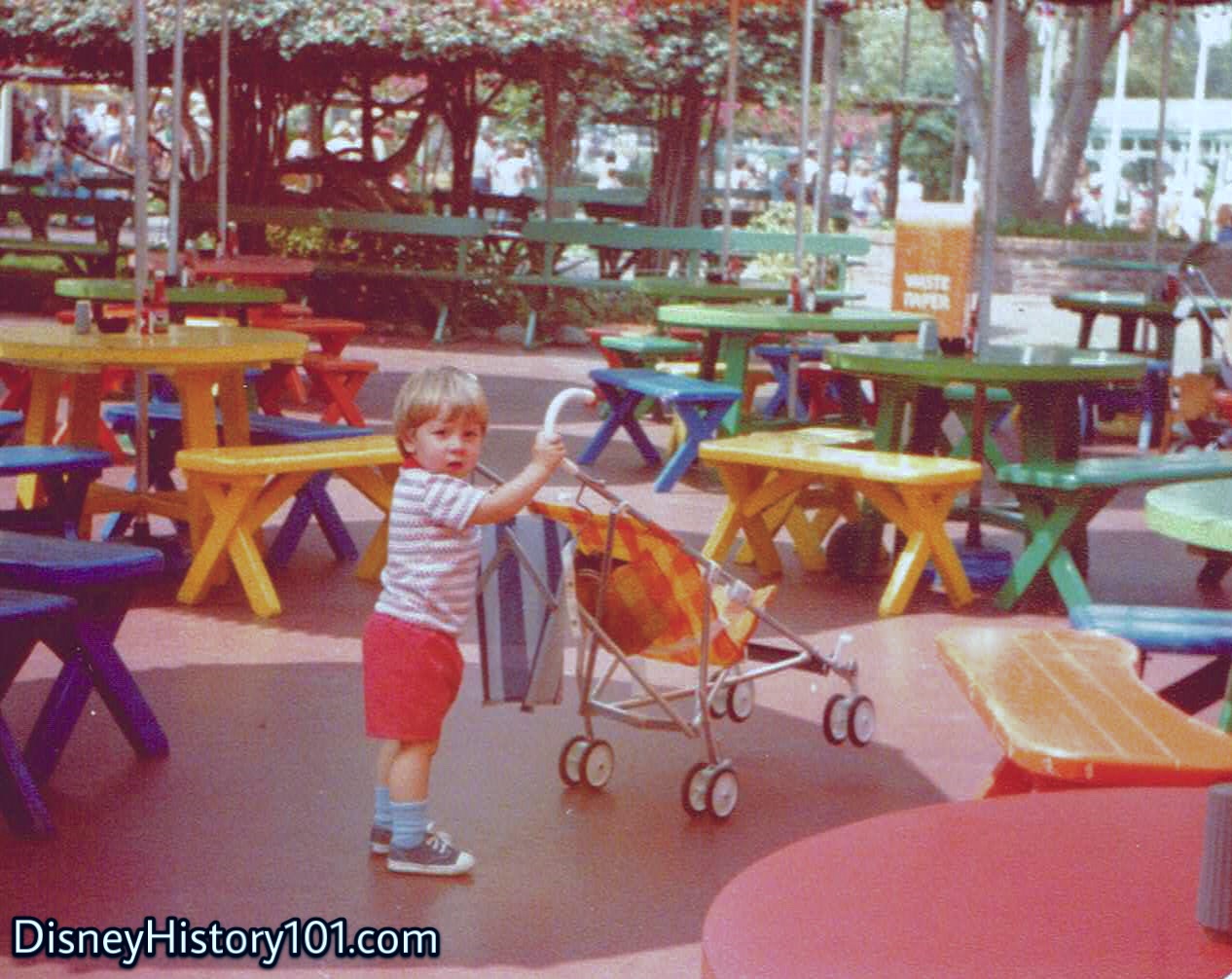
Casa de Fritos, 1978.
By 1975, the benches for Casa de Fritos were being repaired. When the mealtime rush of customers dispersed, the colorful seating of the Casa de Fritos offered a place to rest while enjoying both the sights and sounds of Frontierland! This was also the sight during periods of regular rehabilitations (like in ‘78) which maintained the show quality. In November of 1978, the Frontier Traders Shop reopened from a rehabilitation with increased floor space and enlarged stockroom replacing the old closet. In addition, an access passageway was opened behind Casa de Fritos and the Shooting Gallery to allow the Warehouse drivers to drop off their deliveries backstage. This proved handy for Casa de Fritos Hosts, Hostesses, and other Cast Members for the remainder of the lessee contract.
However, after Disneyland Participant Affairs and Participant Frito-Lay could not negotiate a new cooperative agreement to maintain their ongoing relationship, Casa de Fritos would close its doors. This second incarnation of Casa de Fritos restaurant had been in operation for about two-and-a-half decades (from June of 1957 until October 1, 1982), when it was renamed The Casa Mexicana.
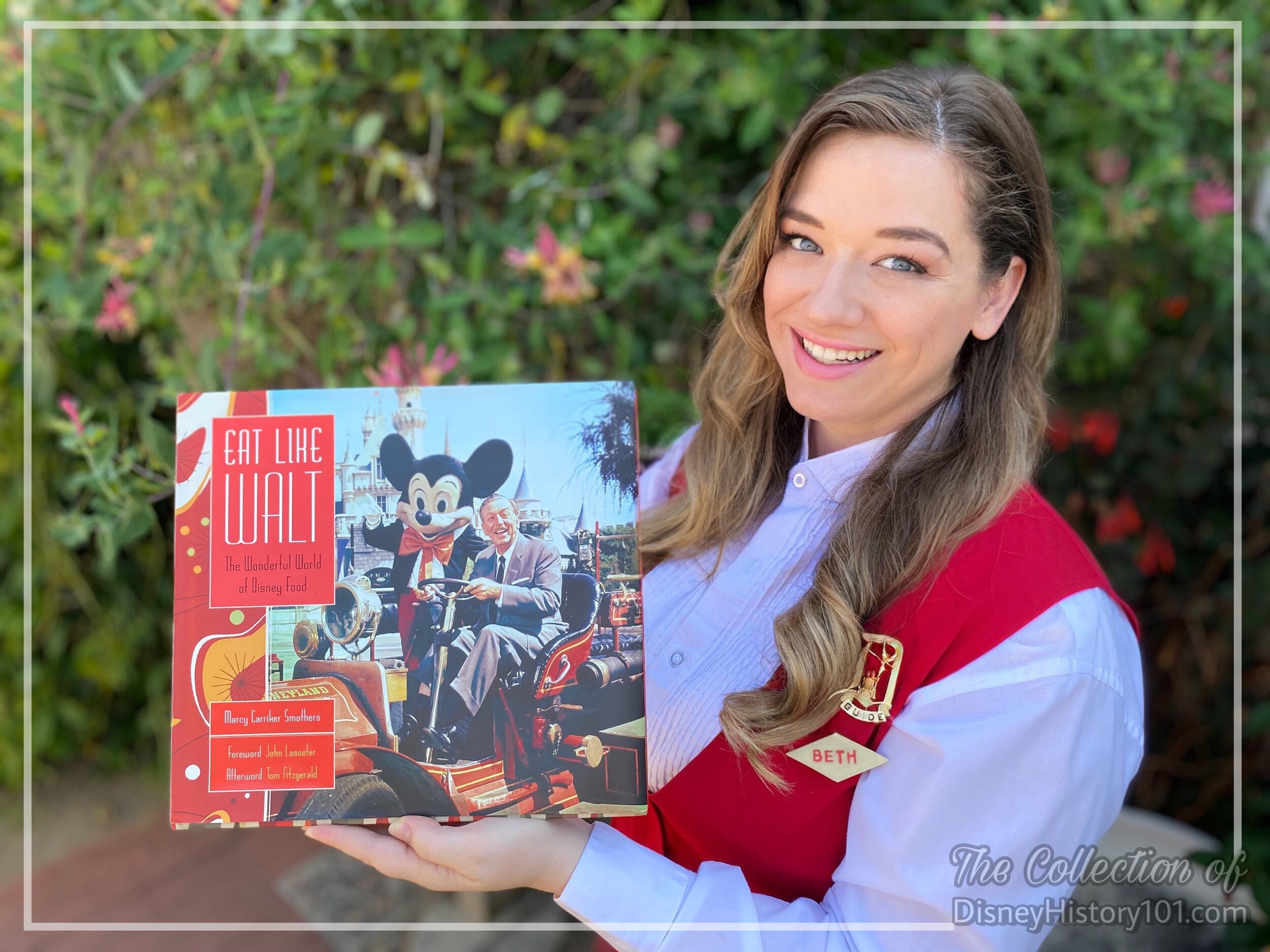
If you would like to read more about the Casa de Fritos, it’s my pleasure to recommend adding Marcy Smothers’ “Eat Like Walt - The Wonderful World of Disney Food” to your personal Disney Home Library! Therein, Marcy has extensively researched and finely crafted a small section of a chapter dedicated to “Walt Disney’s Disneyland - Frontierland” If you would like to bring the magic of Disneyland restaurants and concessions to your dining room table, “please step this way” toward www.eatlikewalt.com where Marcy has shared a few recipes for memorable Disneyland menu options, so you too can “Eat Like Walt.”
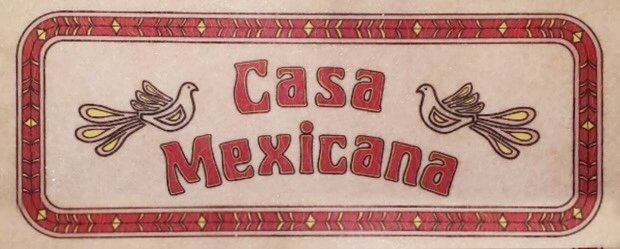
The Casa Mexicana (October 1, 1982* - 1999). *1983 (Disneyland LINE Vol.17 ; No.35)
Lawry’s first developed their “Seazn-All-Salt” steak seasoning in 1938. Since then, the company came to produce “110 different products, 17 of which” were employed in various restaurants around the circa 1983 Disneyland. Casa Mexicana (hosted by new Participant Lawry’s Foods, since May of 1983) captured the feel and flavor of the Mexican Square’s premier attraction, though a refurbishment was in “order”.
During this time Casa Mexicana hosted by Lawry's offered Mexican food specialties, combination plates, (tacos, burritos, and enchiladas) similar to Casa de Fritos’ former offerings were still available in a “buffeteria” setting, and diners could still hear the sound of the mariachi in the square. But now, new variations on these were offered - beef or chicken tacos, shredded beef burritos covered in ranchero sauce, cheese enchiladas, mini beef taquitos, quesadilla rolls, taco salad, nacho platters, and the “Beef Colorado.” Many combination plates allowed guests to experience several of these options, served with rice and beans (of course). “Disneyland Executive Chef Tony Bodner explains that Casa Mexicana offers what might be termed California-style Mexican food. ‘At Casa Mexicana, as at all our Disneyland restaurants, we present an Americanized version of traditional foods,’ he says. We have to gear our recipes to the kind of tastes our audience will accept. For instance, traditional Mexican food would be too hot and spicy for our average American guests. But we’re very quality conscious here, and our recipes convey the style and flavor of the ethnic foods,” according to Disneyland LINE magazine (Vol. 15, No. 41).
According to the very same article, Casa Mexicana used “about 300 pounds of beans and 300 pounds of rice, plus another 300 pounds of cheddar cheese and about 400 pounds of beef” during peak summer days, by account of Disneyland Food Receiver Joey Silva.
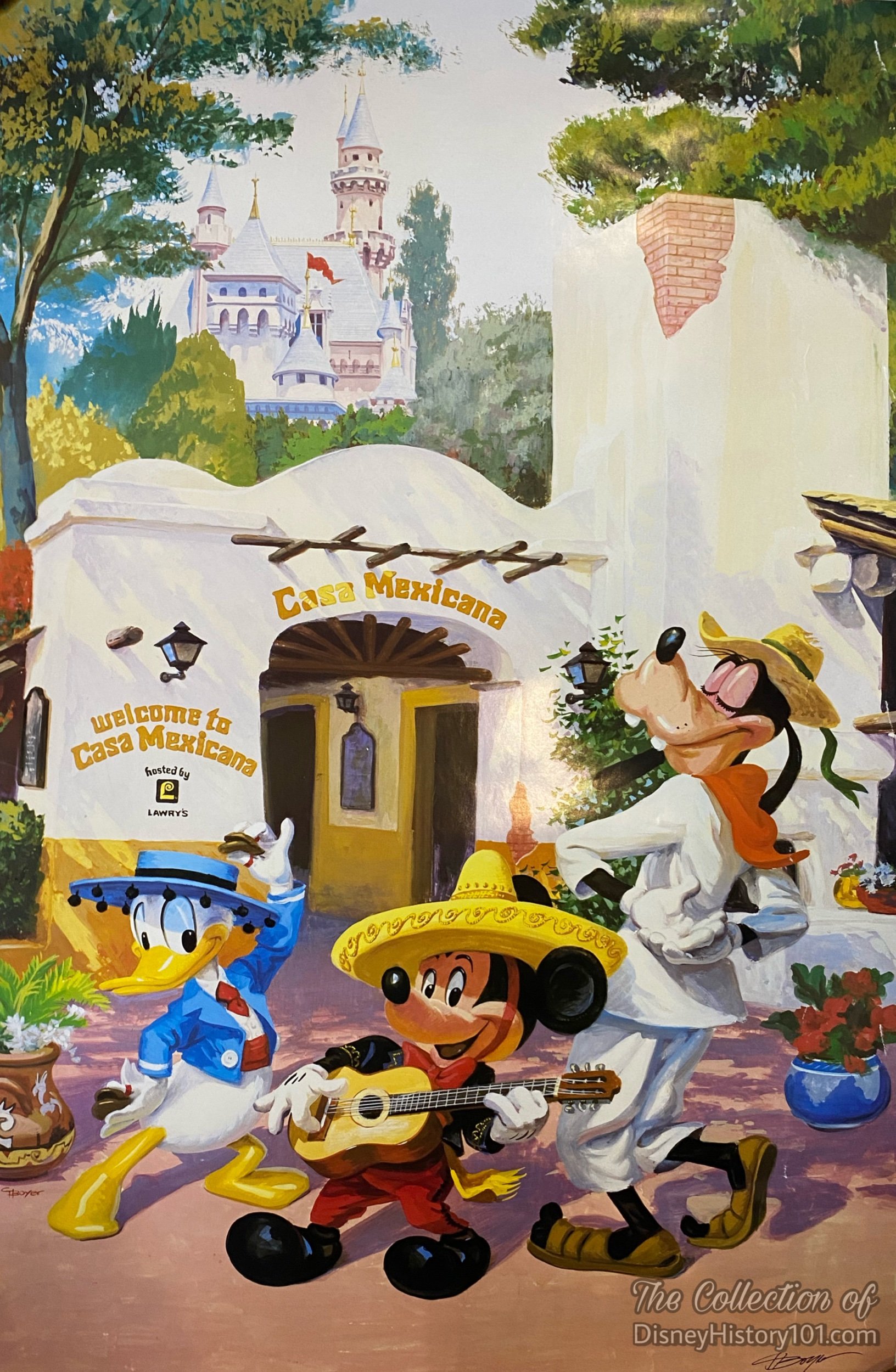
“Casa Mexicana” by Charles Boyer; 1985. Note Disneyland Participant Lawry’s on the wall.
Casa Mexicana occasionally hosted special events, like Private Parties (e.g. GM-Hughes Family Celebration, January of 1986), during which Charles Boyer’s “Casa Mexicana” was occasionally offered as a limited edition print.
By 1990, healthier menu alternatives - Cheese Enchilada, Chicken Taco, and Fresh Fruit Cup - were offered. This incarnation of the restaurant continued for a little more than 17 years, until the opening of Rancho del Zocalo(February/April 2001 - present)!
By 1991, the buffeteria-style Casa Mexicana restaurant was still hosted by Lawry’s Foods and offered “south-of-the-border” specialties including tacos, burritos, and enchiladas.
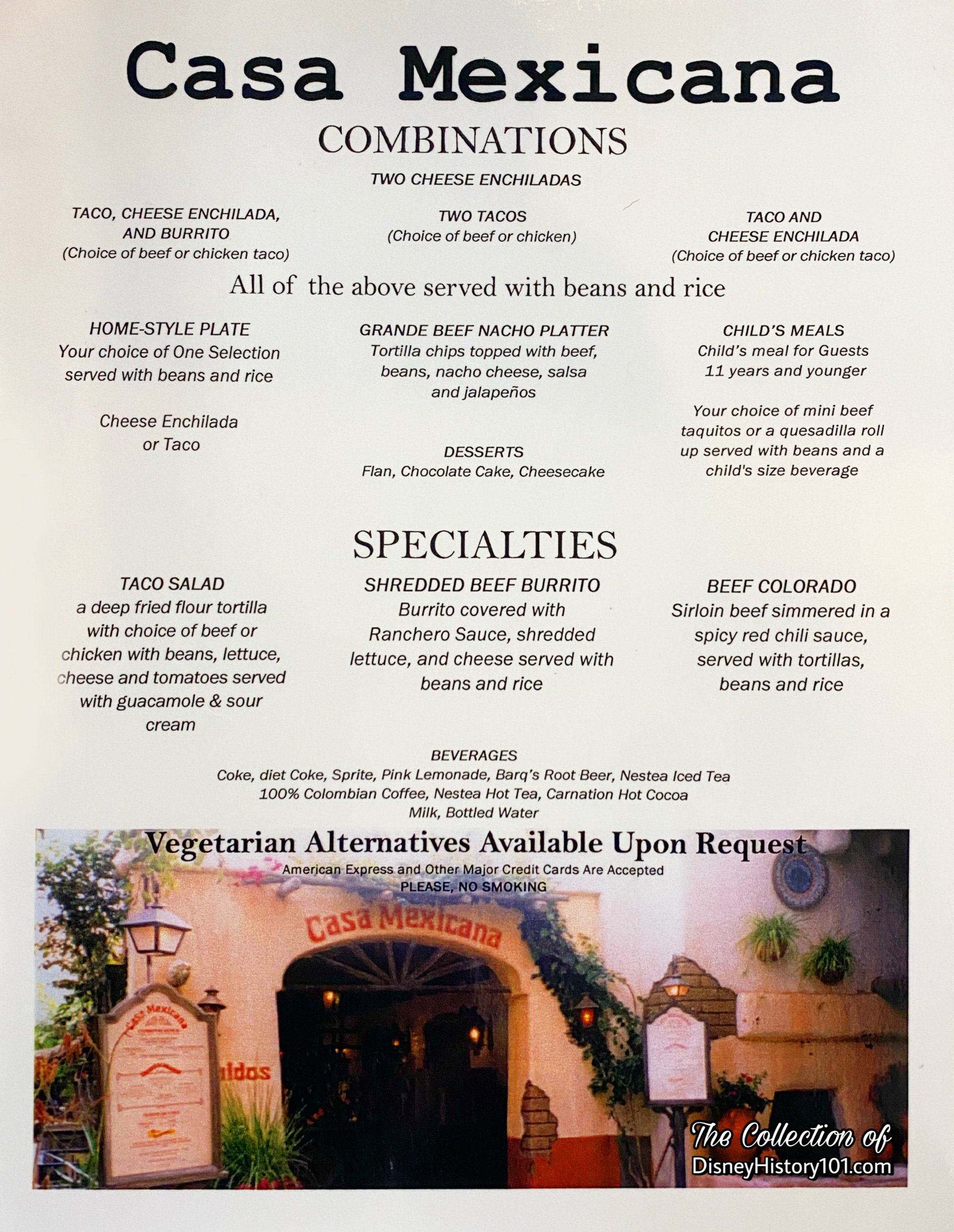
A Casa Mexicana Menu.
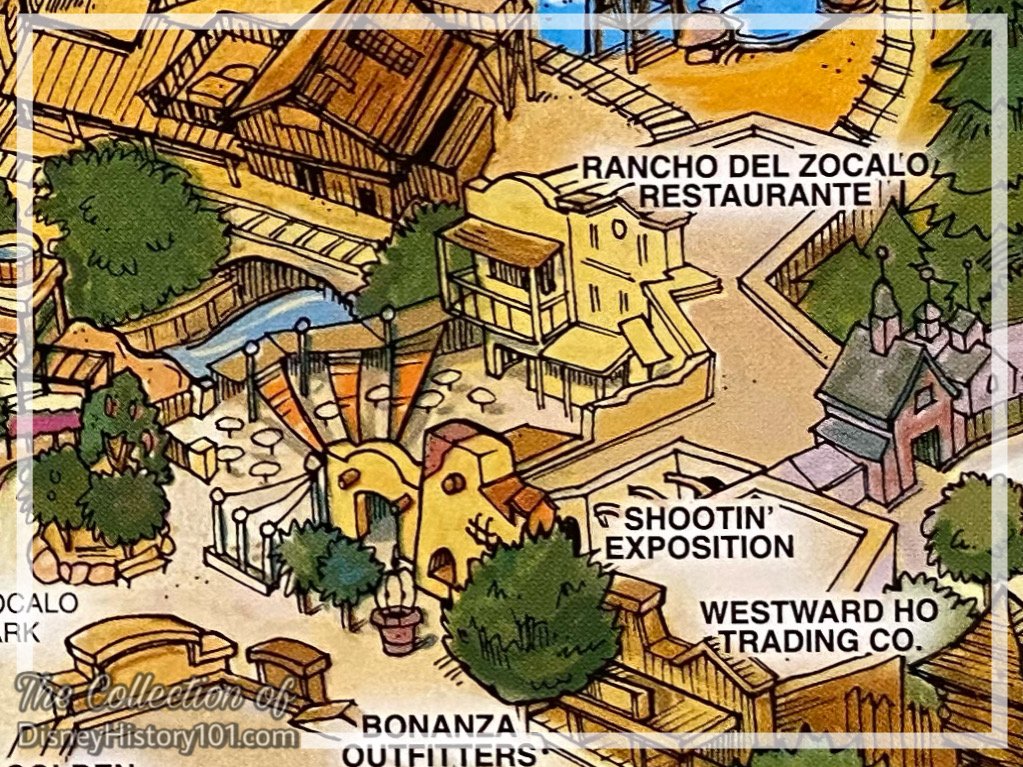
Disneyland 50th Anniversary Map by Nina Rae Vaughn.
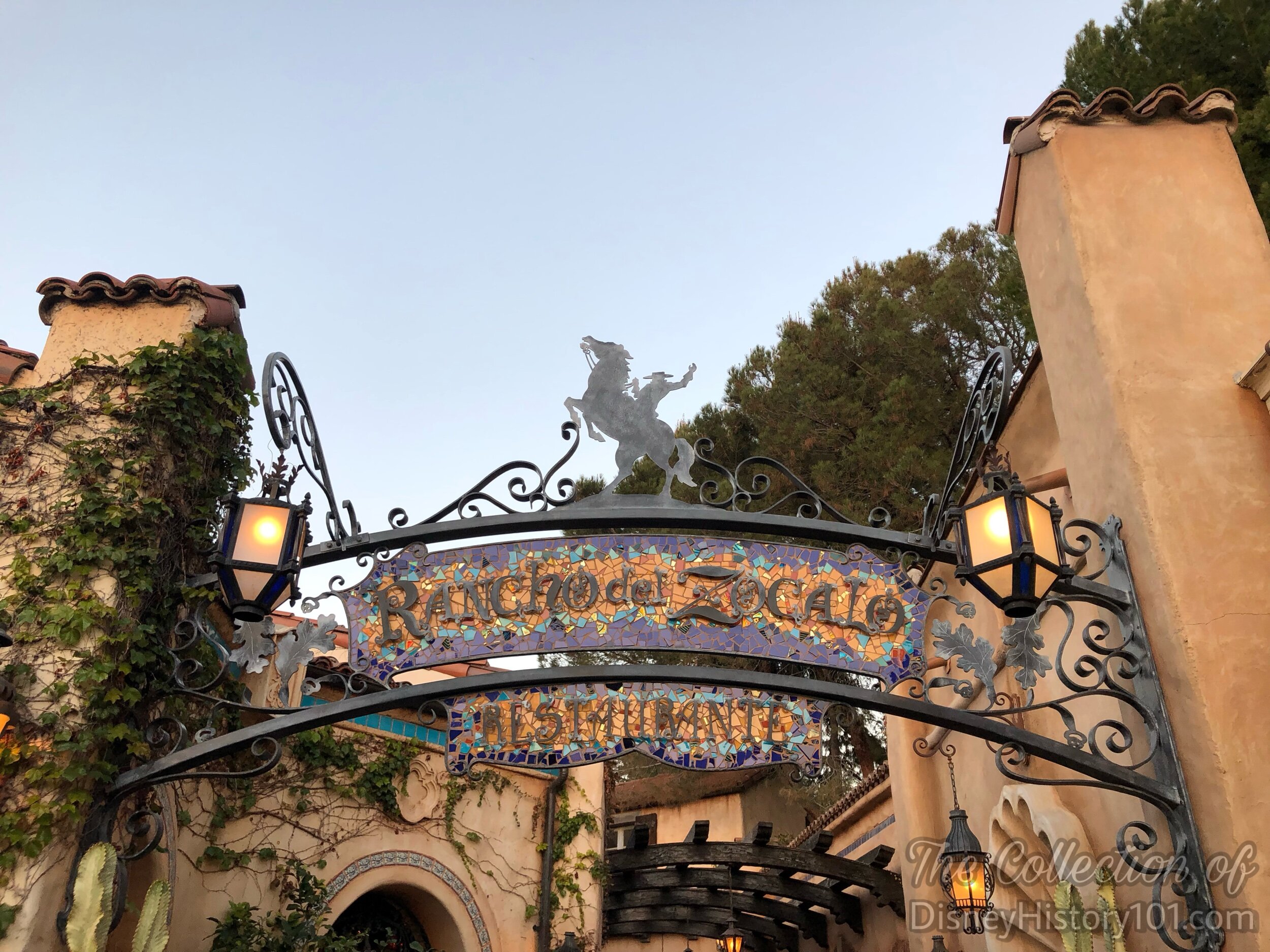
Rancho del Zocalo Entryway
In the present, the menu options and atmosphere have changed considerably since the Casa de Fritos name disappeared from the entrance. The Fritos Street Vendors, Mariachi, and colorful dining areas are all gone, but there is still a festive feel, and a reminder of “the exciting days when the story of our country’s past was being lived” in this section of Frontierland!
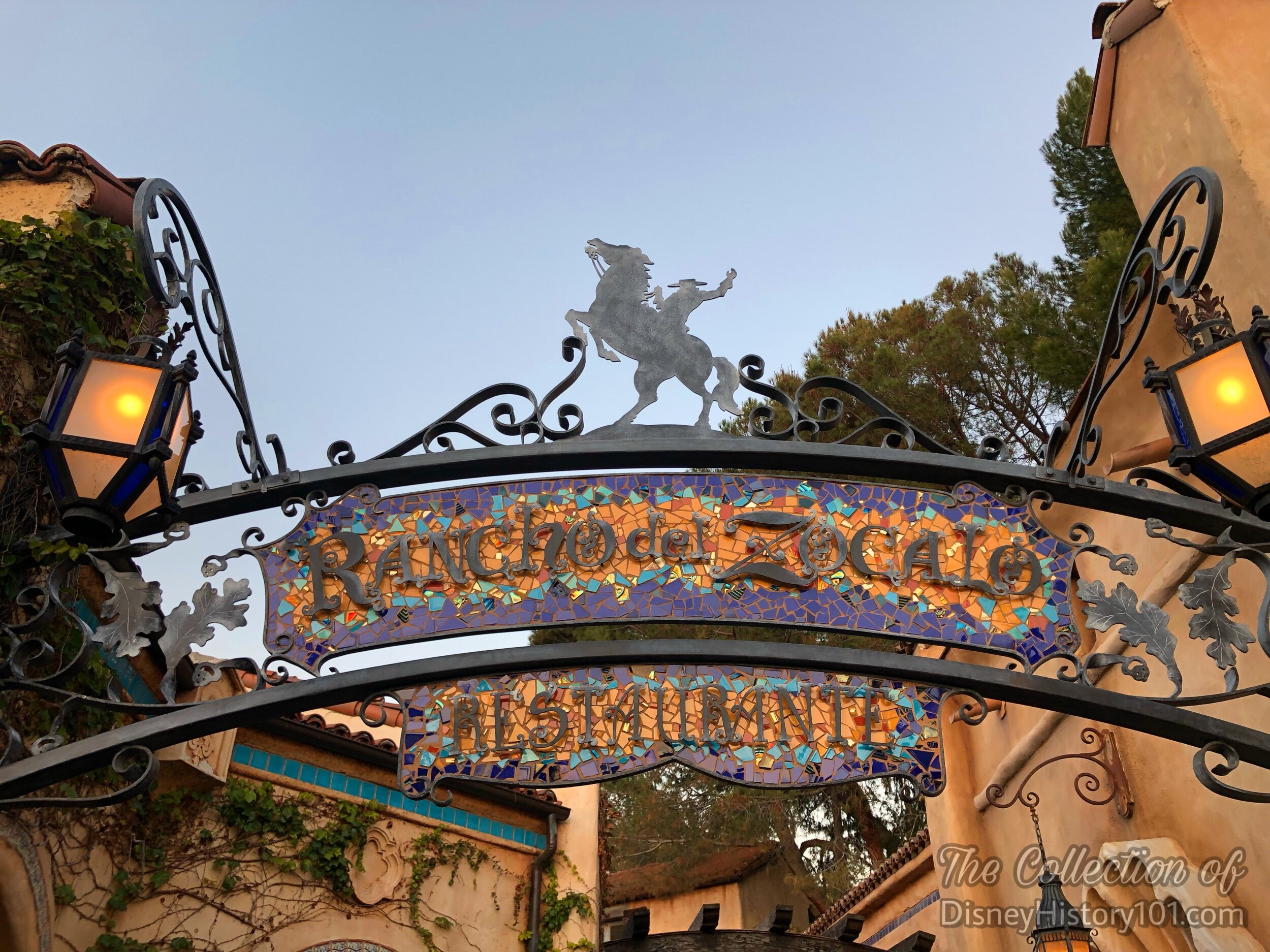
Rancho del Zocalo Entryway carries “the sign of Zorro.”
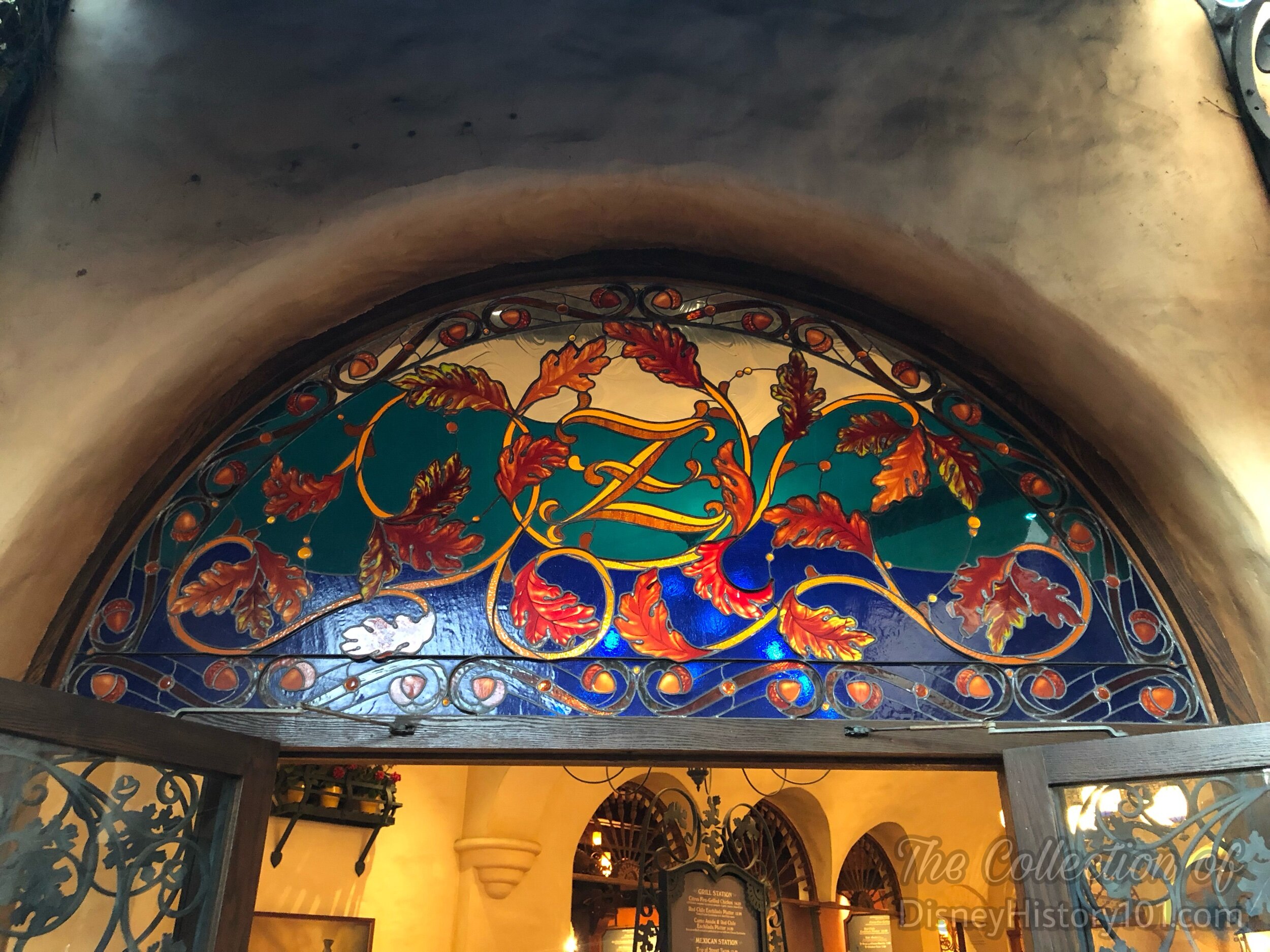
Rancho del Zocalo Stained Glass
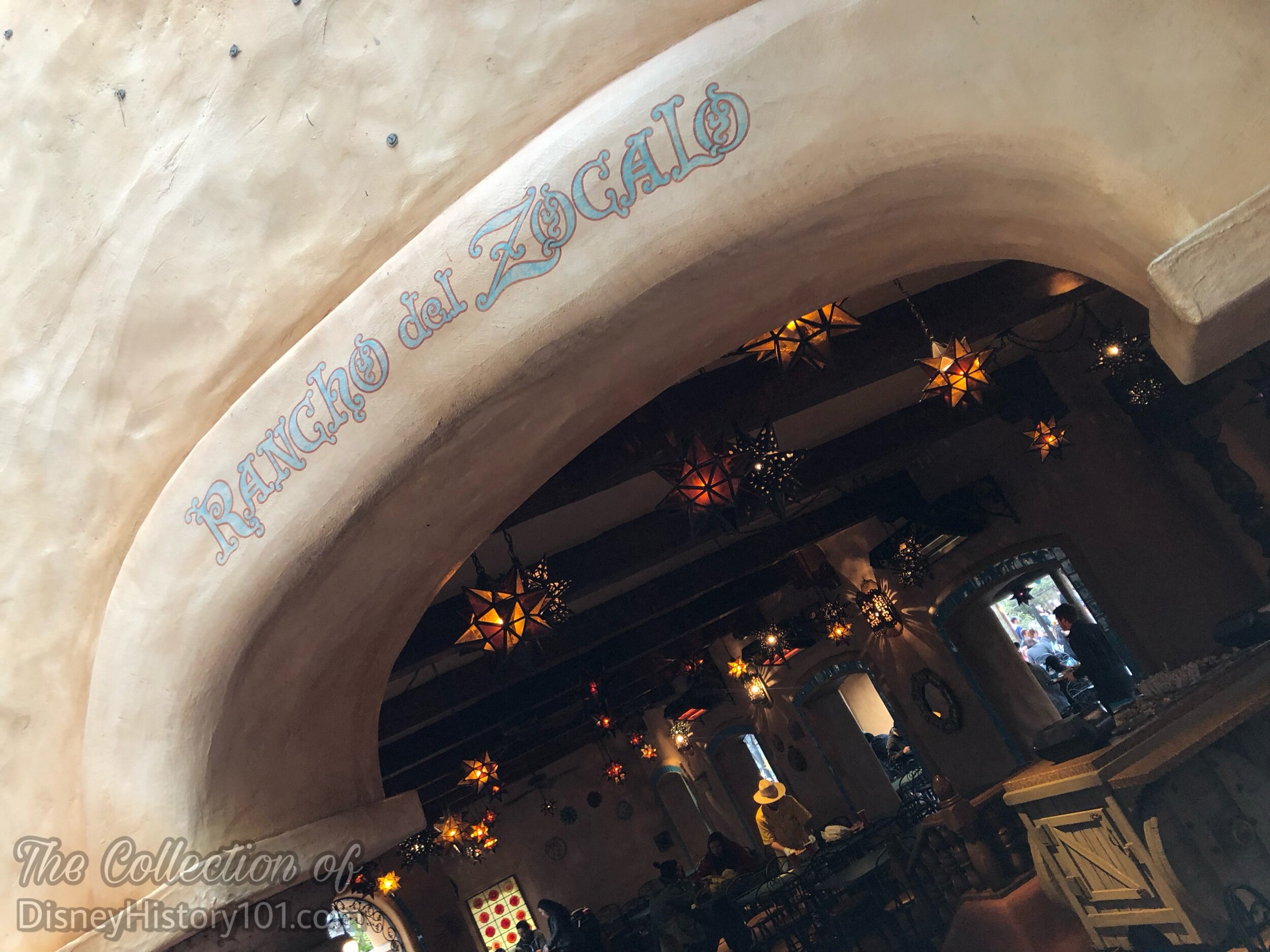
Rancho del Zocalo Dining Room Entryway, (present)
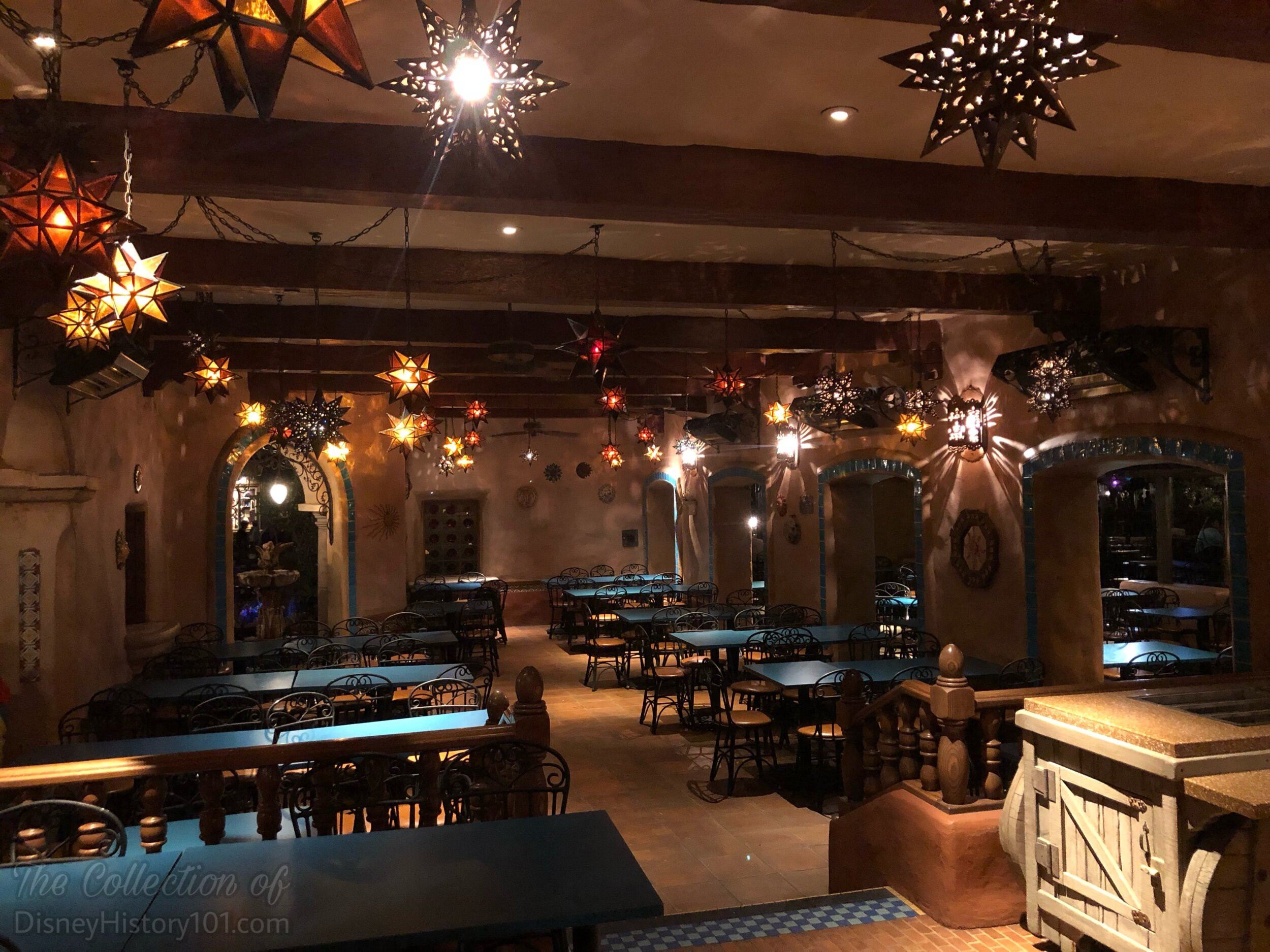
Rancho del Zocalo Dining Room (present)
Character lighting is themed to the area to enhance the overall appearance and complement the interior, such as a chandelier or kerosene lamp. These add to the show, but don't necessarily create enough illumination for operation.
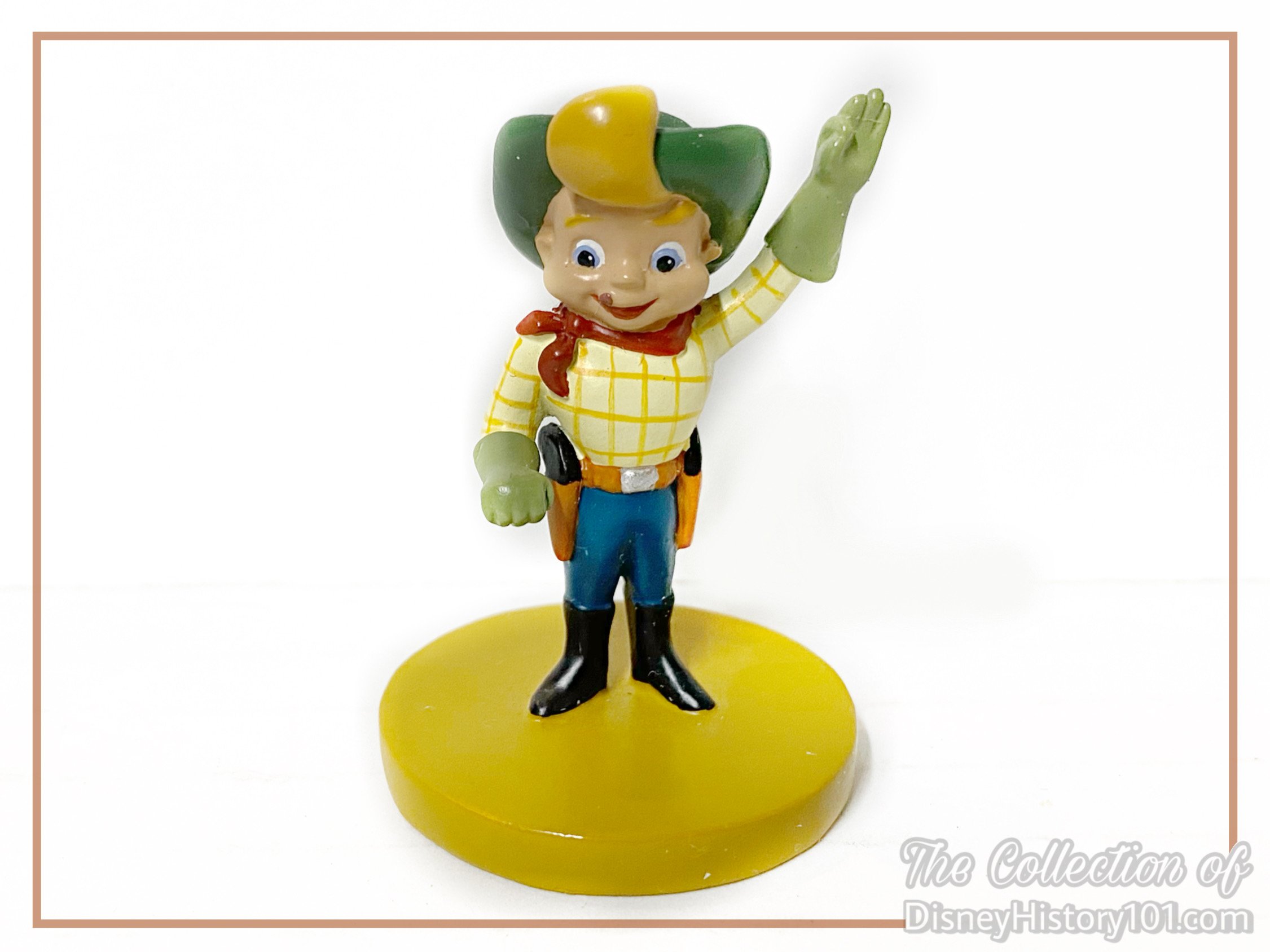
Walt Disney Collectibles Frontierland Pewter Miniatures by Kevin & Jody, 2005.
One of the cutest little homages to Casa de Fritos - this little Frito Kid pewter figure.

